
Common Issues With Beneteau Sailboats

Last Updated by
Daniel Wade
August 30, 2022
Beneteau sailboats are well-made and durable, but these vessels have a few common issues that are exacerbated by age and poor maintenance.
The most common issues with used Beneteau sailboats are strange creaking sounds, fiberglass cracking or delamination, deck core rot, corrosion, keel separation, interior wear, and various wiring and electrical problems.
In this article, we’ll cover some of the issues that you may encounter on older Beneteau sailboats. We’ll go over why these issues occur, how to spot them, and a brief overview of how to repair them. Additionally, we’ll explain why Beneteau sailboats have slightly fewer problems than similar production sailboats.
We sourced the information used in this article from careful research. We also drew off the collective knowledge of the sailing community and the testimony of past and current Beneteau owners.
Table of contents

Are Beneteau Sailboats Well-Made?
Yes, Beneteau sailboats are just as well-made as any other popular production fiberglass boat. The company has produced thousands of affordable boats over the years, and the vast majority of them enjoy years or decades of trouble-free sailing—with regular maintenance, of course.
Former sailboat salesmen sometimes describe Beneteau as “the Ford of the sailboat industry,” alluding that they’re a bit nicer than the other entry-level brands but not quite top-of-the-line. However, modern Beneteau sailboats are much more premium.
Newer Beneteau sailboats are just as high-quality as the old ones—and sometimes better. These vessels have a reputation for quality parts, and few sailors regard them as cheaply-built boats. The cabinet materials, hull glassing, and fittings are generally good from the factory.
Why do Beneteau Sailboats Have Problems?
Beneteau sailboats are some of the better-built production fiberglass boats on the used market. They’re usually stronger than other similarly-priced sailboats due to their hull reinforcements, and many of their fittings are the same as similar vessels and manufactured by third-party companies.
The main reason why we see problems with Beneteau sailboats is due to their age and lower price point. People don’t always take care of their stuff, and most Beneteau sailboats fall victim to time and varying levels of natural deterioration.
Beneteau sailboats aren’t any more or less prone to problems. That said, there are some common issues found on older Beneteau boats that you’re likely to encounter on other sailboats as well.
Common Beneteau Sailboat Problems
Beneteau sailboats are generally well-made and long-lasting, even if previous owners haven’t been 100% on top of maintenance. However, Beneteau sailboats have some generational problems that are common enough to discuss.
Additionally, as the older boats age, the sailing community is becoming aware of potential shortcomings in their construction and design. Luckily, most of these issues can be repaired—if caught early and dealt with promptly. Here are seven of the most common problems with Beneteau sailboats.
1. Strange Noises
Ever heard an old house start to complain on a windy day? The same issue is known to occur on older Beneteau sailboats, but it’s usually not a huge cause for concern. Nonetheless, it’s nerve-wracking for sailors and sometimes a sign of a more serious problem.
When sailing, some Beneteau sailboats will creak and moan—especially in rough seas or high winds. This is likely due to stress on the chainplates, stays, and rigging as pressures are exerted on them. Boats naturally have a certain amount of flex, and sometimes it produces noise.
What’s more concerning is when the noises are a sign of wear on key components or a weakening of the vessel’s structure. This is apparent if you notice cracks around chainplates in the fiberglass or if you see any critical components flexing under normal strain.
2. Fiberglass Delamination
Delamination occurs when fiberglass is exposed to sunlight and weather for extended periods, and the process is worsened by poor or non-existent hull and deck maintenance. Beneteau sailboats are made from multiple layers of fiberglass and a laminate, which can separate from each other over time and weaken the boat.
Delamination can also expose the core to moisture, which can spell disaster for the boat. Luckily, delamination is easy to spot and somewhat easy for amateurs to repair with a kit from West Marine. Any delamination, especially on the deck, should be repaired as soon as you notice it.
3. Weakened or Soft Decks
Deck weakening is caused by moisture which rots the organic core that supports the fiberglass. Not all boats are built this way, but the vast majority of Beneteau sailboats are constructed with a cored deck.
This is a problem that occurs on most fiberglass boats and is not disproportionately common on Beneteau sailboats. So, how do decks go soft, and why is it such a big problem?
Beneteau decks go soft when moisture gets behind the fiberglass. Eventually, once the core has turned to rotten goo, the deck will feel springy or spongy when you step on it. If the problem persists, you could (quite literally) fall through the deck.
Rotten decks can be a nightmare to fix. Usually, the rotted section must be completely cut out and redone with fiberglass and plywood or another structural material. If the rot is isolated, the repair can be completed without too much of a headache.
Beneteau boats with teak decks can also experience rot, as unmaintained wood can weaken and become a splintery mess over years or decades of neglect. A rotted teak deck can be repaired piece by piece. But more often than not, an entirely new deck must be cut and installed.
4. Corrosion
Corrosion is common on Beneteau sailboats, especially the older vessels that have been exposed to the weather for decades. This is why it’s important to cover your winches and keep valuable parts out of the sun and rain.
Corrosion occurs most often on chainplates, rigging, winches, and other metal parts. It can also happen on the mast and boom, especially if the wrong kind of bolts and washers are used. Again, this is a problem that’s due primarily to the age and condition of the vessel.
5. Keel Failure
The dreaded keel failure is one of the most severe problems that can occur on a Beneteau sailboat without sinking it. This occurs because of the design of Beneteau sailboats, which commonly use fin keels of some sort that are laden with heavy ballast.
The keel is mounted to the hull using heavy-duty bolts. It’s not part of the hull—but an additional piece that can separate under the right circumstances. This is usually the result of running aground or bolt corrosion, but there are numerous ways it can happen.
So, how often do keels fall off Beneteau sailboats? Hardly ever—what’s more common is a loosening of the keel, which can rock back and forth and progressively increase the severity of the problem and possibly cause flooding.
If the keel separates, you should have it repaired immediately. This can be done by any competent boatyard, but it isn’t a cheap repair. You can spot a loose keel by looking for cracks or obvious lines around the point where the keel meets the bottom of the hull.
Thankfully, keel separation and failure is relatively rare on Beneteau boats and less common than on other less expensive brands. Vessels should be inspected out of the water if keel separation is suspected.
6. Interior Wear
Beneteau sailboat interiors have always been pretty good, but over time things begin to get loose and worn out. Common points of failure are hinges, which sometimes pull their screws out of wooden cabinets and doors.
Drawers can sometimes become jammed, as early models were built without modern metal sliders. Leaks around hatches and portlights can also occur, especially towards the front of the boat over the V-berth and around ventilation cowls.
This allows rainwater to enter the cabin and cause mold and sometimes leads to deck rot. If water gets into the cabin, even for a short time, there’s a good chance it’ll ruin the upholstery, which must be replaced.
7. Wiring and Electrical Issues
Beneteau sailboats have a pretty good writing layout, but there are a few annoying design decisions that can be difficult to repair. Wiring can corrode if exposed to moisture, and the boat may need to be extensively rewired to get lights and other systems to work.
It may be worth it to disconnect the source and leave old wiring in place, as it can be impossible to locate or remove old cables or re-thread new ones. This would be a bigger issue if the previous owner jerry-rigged anything into the original wiring, as diagrams won’t show it.
Related Articles
I've personally had thousands of questions about sailing and sailboats over the years. As I learn and experience sailing, and the community, I share the answers that work and make sense to me, here on Life of Sailing.
by this author
Learn About Sailboats
Most Recent

What Does "Sailing By The Lee" Mean?
October 3, 2023

The Best Sailing Schools And Programs: Reviews & Ratings
September 26, 2023
Important Legal Info
Lifeofsailing.com is a participant in the Amazon Services LLC Associates Program, an affiliate advertising program designed to provide a means for sites to earn advertising fees by advertising and linking to Amazon. This site also participates in other affiliate programs and is compensated for referring traffic and business to these companies.
Similar Posts

Affordable Sailboats You Can Build at Home
September 13, 2023

Best Small Sailboat Ornaments
September 12, 2023

Discover the Magic of Hydrofoil Sailboats
December 11, 2023
Popular Posts

Best Liveaboard Catamaran Sailboats
December 28, 2023

Can a Novice Sail Around the World?
Elizabeth O'Malley
June 15, 2022

4 Best Electric Outboard Motors

How Long Did It Take The Vikings To Sail To England?

10 Best Sailboat Brands (And Why)
December 20, 2023

7 Best Places To Liveaboard A Sailboat
Get the best sailing content.
Top Rated Posts
Lifeofsailing.com is a participant in the Amazon Services LLC Associates Program, an affiliate advertising program designed to provide a means for sites to earn advertising fees by advertising and linking to Amazon. This site also participates in other affiliate programs and is compensated for referring traffic and business to these companies. (866) 342-SAIL
© 2024 Life of Sailing Email: [email protected] Address: 11816 Inwood Rd #3024 Dallas, TX 75244 Disclaimer Privacy Policy

- Forum Listing
- Marketplace
- Advanced Search
- About The Boat
- Boat Builders Row
- SailNet is a forum community dedicated to Sailing enthusiasts. Come join the discussion about sailing, modifications, classifieds, troubleshooting, repairs, reviews, maintenance, and more!
Online resources for Beneteau owners
- Add to quote
Here are some other online resources for Beneteau owners. Of course, the Beneteau websites http://www.beneteau.com/ http://www.beneteauusa.com/ One of the websites for Beneteau owners http://www.beneteauowners.net/ Another website for Beneteau owners http://www.beneteau-owners.com/ (that website was down when I recently tried it)
I don't mean to be negative about this particular brand, but I'd suggest that another good source on Beneteau products are boat yards, particularly large ones in areas where Beneteaus sell well. These boats seem to consistently suffer from manufacturing problems - or perhaps it's fairer to say they suffer problems when used regularly/demandingly, tho' in ways Beneteau approves of. Boatyards are great places to discover what happens in such cases. I'm at a yard at the moment with two excellent examples. The First 375 that's rafted outboard of us at the moment, waiting its turn for a bottom job, looks to be generally in good shape. However, the deck mold is separating from the hull mold back aft, where the transom line is and where the joint is gelcoated over. Not a gelcoat crack, but a separation. Knowing this makes one begin to think about causes...and therefore understand a bit more about the hull torquing/racking in a seaway and perhaps what limits exist for Beneteaus in this regard. Another example is up on the hard, a 3-yr old Beneteau 57, roughly a 600,000 Euro boat. Fuel tank vents have led to her injection pump being demolished and needing replacement (altho' this was equally due to inadequate pre-filtering of the fuel) and a number of other systems issues. But the big surprise is her ballast keel. In addition to a noticeable gap in the keel/keel stub joint, we're seeing a crack that started at the trailing edge of the keel, slowly working its way horizontally and forward, apparently trying to mate up with the main section of the keel where it mates with the hull. (The mating surfaces are 'stepped' on this keel stub/keel rather than being one straight horizontal line). Beneteau has refused to address this, suggesting the crack be filled with putty. When deciding to 'bolt' the keel sections together and inhibit further crack creep, the vendor who does this work discovered the keel wasn't all lead, but rather a lead casting covered with an aluminum alloy. (What strange arrangement is this?! Well, the keel was made by a subcontractor...and so who knows; Beneteau doesn't). In this case, we learn multiple things: Beneteau's attitude towards warranty claims, subcontracting of keels, and specific defects - none of which we would probably assume when first learning about the boat. Just like Jeanneau, Catalina, Hunter (Legend in the UK) and Bavaria, Beneteau makes a large number of boats, year in & year out. Many are lightly used; others are used sufficiently to begin surfacing issues like those above. Digging around yards will help identify some of them; networking with other owners who use their boats extensively is another way. Some Beneteaus - moreso the First series - hold up well; some do not. Jack
WHOOSH said: I don't mean to be negative about this particular brand, but I'd suggest that another good source on Beneteau products are boat yards, particularly large ones in areas where Beneteaus sell well. Jack Click to expand...
Thank you Jack Jack, I appreciate your post regarding the poor build quality of Beneteaus. I came very close to purchasing a new Beneteau until I was warned of their construction challenges. As I began to follow-up on these rumours, I came across multiple users of this boat and I am thankful that I did not spend the money to buy one. Apparently these boats can require serious repairs after a few years of regular use. Resell values are not good at all. While I know your post was some time ago, I'm wondering if you (or anyone) can recommend a production sailboat that can stand the test of time and coastal cruising with the odd offshore venture without having to step up to a much more expensive custom built boat. I'm looking for a near new 42-45 foot sailboat under $250K. Thanks in advance. Al
Al...I think the Catalina 42 is going the be the best boat in your specified size/price/age range in terms of decently available boats. You may find a bargain somewhere on a more limited production boat. This Valient is a bit higher than your range but is certainly an exceptional boat: YachtWorld.com Boats and Yachts for Sale
First 42 Got to agree with that last post, you will find good and bad in all boats and it kinda depends on how the person treats thier personal property. The wife and I performed an unspeakable act as said by some racers by turning our 1983 First 42 into a Full fledged Cruiser, solar pannels, windcharger, and more gel cell batteries than you can carry in a normal pickup at one time. And for the past 6 years we've been sailing the waters from the North West to Mexico and with this last big retro-fit which included, my wifes best friend, a spectra watermaker, we're now ready to leave for a 5 year trip around the world.. Mine is equepted with a deep keel and a tall rig and there's times we use every bit of it. and the speeds, I've seen speeds that would make you call me a liar and all the time, a velvet touch control. Those that own a First 42 know of what I'm speaking.. Dont put the Beneteau down because of a few you've seen that have been mistreated, and take the time to check out the First 38 and 42.
Very Unfair..... When you build Thousands and Thousands of sailboats, the chances are that some will be better than others, in terms of design, manufacture and materials quality. I searched for a boat for many many years. I looked at C&C, CS, Tartan(way over rated), Jeanneau, Newport, Beneteau, Pearson and others. There are good and bad boats in every one of them. I ended up with a Beneteau because it was the best deal. My boat is as stronger and faster than most of the boats I saw. The hull is two inches thick in some areas and the deck feels like you're stepping in concrete so whoever makes a general statement saying that this or that brand is bad, is in my book, full of cr#@p. So,, if you find a good Beneteau, inspect it well and go for it. It is very likely that you will beat most of the critics, IN THE WATER. Check this out:
Not that owning a B makes me biased, but WOOSH can go to another yard and find similar problems on any boat in the yard. Funny post, although if he is out to save the people from making the mistake of buying a Bene he is on his way. Greg
We're on our 4th Benny and loved every one of them. They're fast, great boats but of course if you beat them up and neglect them you'll get what you expect. Take care of them and they'll take care of you. BTW I find they hold their value fairly well. We've seen 80 to 85% retention in value with all of them. All at least 7+ yrs old when sold or traded.
Beneteau is the largest volume boat builder in the world therefore you will see more of them in marinas and more of them in yards under repair. They are also used extensively in charter fleets (Moorings for example) where they see a lot of work. WHOOSH's comments are not of much value to me. From what I know of Beneteau they use some of the most advanced manufacturing techniques and equipment available - allowing them to provide well made boats at good value. Every boat is an assembly of many manufacturers - engines, winches, rigging, sails, pumps, batteries etc. so nailing one boat builder for 'quality' issues is crazy. The builder makes the hull and fits the rigging and equipment - I saw one posting where a guy was nailing C&C because his Yanmar sail drive failed - in fact he tried to sue C&C - crazy stuff. It seems to me the key to having a good boat is to keep it maintained after it is manufactured. There is a lot of junk in every marina - look hard enough and you might even find a dilapidated Swan.
Proud owner of 10 year old 381. We love her and she sails and shows great! Fredb and Randi SV Sugar Magnolia
Beneteau Oceanis 43 power winch Hello. I own a B oceanis 43. I will be installing a power winch kit to the mail sail winch and possibly to the genoa winch. I was wondering of if I should buy the vertical or the horizontal motor options. Any feedback would be highly useful. Thanks. T
I have seen two rudder post problems of loose banging and leakage. Beneteau 411 and a first 47.7 Have others seen this problem and how was it solved?
Beneteaus sell more boats than anyone else. Statictically there will be more *anywhere*, including at boat yards. According to the tri-data, our 10 year old Beneteau 505 has loggged 16,000+ nautical miles and shows well. Engine has 5,000 hours still runs strong. Windlass needed repairing (Lofrans, great quality, an internal spring broke). She was in the Mooring fleet, so you know she saw some real service. I'm really glad I found her and that some other buyer didn't swoop her up before I had a chance to buy her. My surveyor said to buy her too. (He looked very wistful as she was being hauled for inspection and cleaning.) Besides being a Beneteau fan, I'm also a "production" fan. Hondas break a lot less than Ferraris because they build so many of them, over time they know what to do, what works and what doesn't, for a very reasonable price. If funds were no object, I would buy a Ferarri, but I'd still have a production car for regular, all-around use. I suppose my point with "production" is that you get a lot for your money. Regards, Brad
- ?
- 173.8K members
Top Contributors this Month

What is Beneteau and why should you by one
Dive into our extensive guide on Beneteau sailboats. Discover insightful perspectives, arguments and competitors - everything you need to set sail on a Beneteau
October 20, 2023
Date Posted:
June 28, 2023
Beneteau is a renowned French company that manufactures a wide variety of boats, including sailboats. The company was established in 1884 by Benjamin Beneteau and has grown over the decades to become one of the leading boat manufacturers worldwide.
The Beneteau brand is synonymous with innovation, quality, and seaworthiness. They produce different sailboats designed for various uses, from cruising to racing. The company’s sailboat range includes small boats for casual sailing, larger yachts for extended cruising, and even high-performance boats for competitive sailing.
Beneteau’s most popular sailboat lines included the Oceanis, First, and Sense series.
- The Oceanis line is designed for comfort and ease of use, making it ideal for cruising and liveaboard sailors. These boats are known for their spacious interiors, excellent build quality, and efficient sailing characteristics.
- The First series is targeted towards racing and performance-oriented sailing. These boats have sleek, streamlined designs and are built for speed while still offering some cruising comforts.
- The Sense series offers a unique blend of sailing performance and liveaboard comfort, with features designed for long-distance blue water cruising. They are known for their innovative layouts that provide an easy and seamless transition between indoor and outdoor spaces.
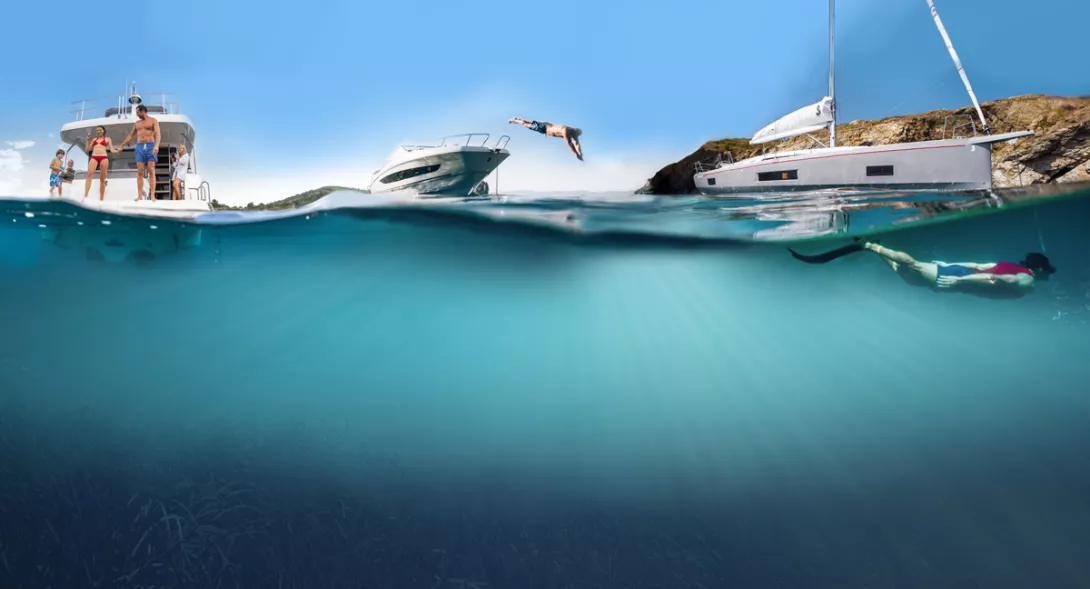
3 reasons to buy a Beneteau sailboat
Versatility and variety.
Beneteau offers a diverse range of boats to suit various needs and preferences. Whether you are looking for a performance-oriented sailboat for racing, a comfortable yacht for leisurely cruising, or a motorboat for fishing and day trips, Beneteau has options that cater to a wide spectrum of boating enthusiasts. The extensive range allows you to find a boat that aligns closely with your intended usage and style preferences.
Innovation and Modern Features
Beneteau is known for staying at the forefront of technological innovations and incorporating modern features in its boats. The company’s boats often come equipped with cutting-edge navigational systems, efficient hull designs, and luxurious amenities that enhance comfort and performance. A Beneteau boat can be an appealing choice for someone who values modernity and state-of-the-art features.
Global Support and Resale Value
Owning a Beneteau comes with the assurance of a broad global support network, thanks to the brand’s international presence. This makes it relatively easy to access service and maintenance, even if you are cruising in different parts of the world. Additionally, Beneteau’s reputation as a reliable and well-regarded brand often translates to strong resale values. For those who may wish to upgrade or sell their boat in the future, this can be an important financial consideration.
Beneteau is one of the largest boat manufacturers in the world and has an extensive history that spans over a century. Beneteau was founded in 1884 by Benjamin Beneteau, a shipbuilder who began by building fishing boats in the Vendée region of France. Over the years, the company expanded its operations to include both sailboats and motorboats, and it is now a multinational company with a presence in multiple countries worldwide.
Innovation and Design : Beneteau is known for its innovative designs and use of modern technology. The company has introduced numerous design features that have influenced the boating industry. For example, they were among the first boat builders to use GRP (Glass Reinforced Plastic) to construct their boats, which is now standard in the industry.
Global Presence : The company operates internationally, with dealerships and manufacturing facilities in multiple countries, including the United States and Poland. Beneteau’s boats are sold all over the world.
Environmental Responsibility : Beneteau is committed to environmental responsibility. The company strives to minimize the environmental impact of its manufacturing processes and has implemented numerous sustainability initiatives over the years.
Heritage and Reputation : With over a century of experience, Beneteau has a strong heritage and reputation in the boating industry. The brand is synonymous with reliability, and owning a Beneteau can be seen as an endorsement of quality.
Innovation and Technology : Beneteau is known for incorporating cutting-edge technology and innovative designs in their boats. They have been pioneers in many aspects, including hull design and manufacturing techniques. This means that with a Beneteau, you’re likely getting some of the latest features and innovations.
Wide Range of Options : Beneteau offers a diverse range of sailboats, from small, performance-oriented models to large, luxurious cruising yachts. This diversity makes it easier for buyers to find a boat that fits their specific needs and preferences.
Resale Value : Beneteau sailboats generally have good resale values due to the brand’s reputation and demand in the used boat market. This can be an important consideration for buyers looking at the total cost of ownership over time.
Global Support and Dealership Network : As an international brand, Beneteau has an extensive dealership and service network across the globe. This makes it easier to find service and support for your boat, no matter where you are.
Comfort and Liveability : Many Beneteau models, especially in the Oceanis range, are designed with a focus on comfort and liveability. They often feature spacious interiors, efficient layouts, and amenities that make them suitable for extended cruising and living aboard.
Performance : Particularly in their First series, Beneteau has models that are performance-oriented and well-regarded in the racing community. This is ideal for sailors who are looking to participate in regattas or who simply enjoy a more sporty sailing experience.
Community : Owning a Beneteau can also provide you with access to a community of fellow owners. There are clubs and associations for Beneteau owners, and being part of this community can be both socially rewarding and practical, as experienced owners can be a good source of advice and support.
Motorboats : In addition to sailboats, Beneteau also manufactures a wide range of motorboats. These include small outboard motorboats, larger inboard cruisers, and luxury motor yachts. They also have ranges of powerboats for different uses, from day-boating to cruising and luxury yachting.
Beneteau competitors
Beneteau has several competitors in the sailboat and motorboat markets. The boating industry is quite diverse, and the major competitors can vary depending on the type and size of the boat. Here are some of the notable competitors in the sailboat market:
- Jeanneau : Like Beneteau, Jeanneau is a French brand often considered one of Beneteau’s closest competitors. They offer a similar range of sailboats known for quality and performance. Interestingly, Beneteau and Jeanneau are part of the same parent group, Groupe Beneteau.
- Bavaria Yachtbau : A German brand, Bavaria is known for producing well-built sailboats and motorboats. Their Cruiser and Vision series of sailboats are particularly popular among cruising enthusiasts.
- HanseYachts AG : Another German manufacturer, Hanse produces a range of modern and innovative sailboats. They are known for their easy handling, performance, and customizable designs.
- Dufour Yachts : Also based in France, Dufour manufactures cruising sailboats known for their performance, quality, and comfort. They have a range of models suitable for both coastal and blue-water cruising.
- Catalina Yachts : An American brand, Catalina Yachts produces a range of sailboats known for their durability and value. They have a loyal following, particularly in the United States.
- Hunter Marine : This is another American brand well-known for producing cruising sailboats. They offer boats with a good balance of comfort, ease of use, and performance.
- Elan Yachts : Based in Slovenia, Elan builds performance-oriented cruising sailboats. They are known for incorporating innovative features and designs in their boats.
Submit a YouTube channel
Ad your favourite or own YouTube channel to the index
You Might Also Like…
- Fire puts an end to a sailing channel.
Just a random website for/by Sailors
- New Sailboats
- Sailboats 21-30ft
- Sailboats 31-35ft
- Sailboats 36-40ft
- Sailboats Over 40ft
- Sailboats Under 21feet
- used_sailboats
- Apps and Computer Programs
- Communications
- Fishfinders
- Handheld Electronics
- Plotters MFDS Rradar
- Wind, Speed & Depth Instruments
- Anchoring Mooring
- Running Rigging
- Sails Canvas
- Standing Rigging
- Diesel Engines
- Off Grid Energy
- Cleaning Waxing
- DIY Projects
- Repair, Tools & Materials
- Spare Parts
- Tools & Gadgets
- Cabin Comfort
- Ventilation
- Footwear Apparel
- Foul Weather Gear
- Mailport & PS Advisor
- Inside Practical Sailor Blog
- Activate My Web Access
- Reset Password
- Pay My Bill
- Customer Service

- Free Newsletter
- Give a Gift

How to Sell Your Boat

Cal 2-46: A Venerable Lapworth Design Brought Up to Date

Rhumb Lines: Show Highlights from Annapolis

Open Transom Pros and Cons

Leaping Into Lithium

The Importance of Sea State in Weather Planning

Do-it-yourself Electrical System Survey and Inspection

Install a Standalone Sounder Without Drilling

When Should We Retire Dyneema Stays and Running Rigging?

Rethinking MOB Prevention

Top-notch Wind Indicators

The Everlasting Multihull Trampoline

How Dangerous is Your Shore Power?

DIY survey of boat solar and wind turbine systems

What’s Involved in Setting Up a Lithium Battery System?

The Scraper-only Approach to Bottom Paint Removal

Can You Recoat Dyneema?

Gonytia Hot Knife Proves its Mettle

Where Winches Dare to Go

The Day Sailor’s First-Aid Kit

Choosing and Securing Seat Cushions

Cockpit Drains on Race Boats

Rhumb Lines: Livin’ the Wharf Rat Life

Re-sealing the Seams on Waterproof Fabrics

Safer Sailing: Add Leg Loops to Your Harness

Waxing and Polishing Your Boat

Reducing Engine Room Noise

Tricks and Tips to Forming Do-it-yourself Rigging Terminals

Marine Toilet Maintenance Tips

Learning to Live with Plastic Boat Bits
- Sailboat Reviews
The Catalina 270 LE vs. The Beneteau First 265
In a head-to-head comparison of entry level inboard cruisers, we think the lower price and practicality of the catalina favors it over the glitter and gloss of the beneteau..
People who start in small boats and trade up often view 27 feet as some kind of milestone, and rightly so. At around 27 feet, an inboard engine and the possibility of standing headroom are enticing. Accommodations often become spacious enough for two couples or a family of four to live aboard for a couple of weeks without strain. And hull speed with appropriate sail and engine power typically permits average-weather runs of 35 to 40 miles in an 8-hour day-long enough legs to satisfy the wanderlust of most cruisers.
Two of the newest 27-foot cruising boat designs are from Beneteau and Catalina, both huge builders. Beneteau bills itself as the largest sailboat company in the world; Catalina lays claim to being the largest in the U.S. The new designs of both companies often set the tone for styling by other sailboat makers.
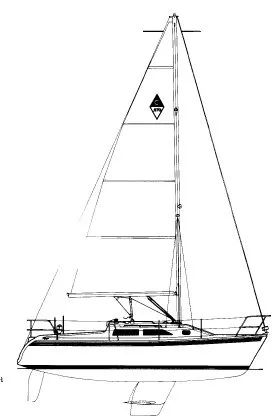
Checking out both boats at a recent show, we noticed that the base list price of the Beneteau First 265 with inboard ($38,050) was less than 10 percent above the base for the Catalina 270 LE ($34,775). Their Euro-styled interior layouts were at least superficially similar as well, as were hull and sail plan dimensions. Which boat, we wondered, is the better buy, and for whom?
Both the Beneteau and the Catalina utilize modern wide-body, fin-keel, spade-rudder configurations, relatively long waterlines, and moderate rigs with shrouds moved inboard to permit a narrower sheeting base. The Beneteau has a slightly shorter LOA but longer LWL (length waterline), and a nearly plumb bow. The 265’s draft is mid-range (4′ 2″ vs. the Catalina’s choice of 5′ 0″ deep fin or 3′ 6″ fin with wings).
Both test boats have inboards. Catalina does not offer an outboard option as it once did with its old 27. Catalina’s chief engineer, Gerry Douglas, doesn’t think it’s suitable for a 27- footer, especially one weighing 6,400 pounds-and, he says, neither did most buyers of Catalina 27s over the last several years. (Among other problems, in a seaway an outboard prop tends to ventilate too much).
Still, Beneteau, with a 4,800-lb. boat, does offer an outboard version (base price $32,900 excluding engine, which is $5,150 below the inboard Beneteau price with engine) and recommends a 9.9-hp. outboard for those who wish to go this route. So far, few buyers have. Beyond the ventilating prop problem, the reason is mostly economic: By the time Beneteau buyers acquire the outboard engine and associated paraphernalia, the difference between inboard and outboard shrinks to around $3,500-and those who opt for the outboard miss the shore power option and electric hot water heater option which Beneteau throws in” free” with the inboard package.
The rigs of the two boats may appear quite similar at first glance, but upon close inspection a number of important differences emerge.
The Beneteau features a seven eighths rig with single spreaders, adjustable split backstay, mast stepped on deck with compression strut in the cabin, and shrouds tied into a force grid molded into the cabin top via a set of studs threaded into a patented configuration involving stem balls set into bronze plates. (We’d prefer a set of conventional-and more easily adjustable and replaceable turnbuckles.) The mast is stepped on a hinge for lowering the spar at bridges, trailer ramps, or for maintenance, but Beneteau says use of the hinge is not recommended without side-sway preventers- currently available as an option in Europe, but not in the U.S.
The Beneteau’s genoa sheets lead to cars riding on C-shaped aluminum tracks, which double as handrails, on the cabintop. It’s not easy to grab the tracks/rails, which require feeding your fingers through a narrow slot molded in to the coach roof. We’d rather see separate handrails. We’d also prefer to see the Beneteau’s cockpit mounted mainsheet traveler track moved forward onto the cabintop (as the Catalina is configured), so crew moving from cockpit to cabin don’t have to dodge the mainsheet and car. But, unfortunately, moving the track forward isn’t feasible because of the long companionway bridge deck, which reaches forward beyond the boom’s midpoint.
The Catalina’s masthead rig, even with double spreaders (permitting use of a lighter spar than the Beneteau), is more conventional. Although the Catalina’s mast is shorter and its mainsail is smaller, the foretriangle height is two feet longer than the Beneteau’s, resulting in more total sail area when setting a big genoa.
The Catalina’s rig design strives for simplicity (no backstay bridle adjustment, no line-adjusted genoa car position as on the Beneteau), and ease of use. Helping to make sailing the Catalina a no-hassle experience is an impressive array of standard equipment not seen on the Beneteau: A double-ended mainsheet, adjustable either at a cam cleat on the traveler car or at a cabin top stopper, where a winch can be used; a pair of two-speed Lewmar self-tailing #30s (compared to Beneteau’s single speed #16s); a standard 135-percent genoa on a goodquality Hood single-line furler (compared to Beneteau’s standard 100-percent jib and furler hardware available only as an option); a total of five cabintop stoppers (vs. three for the Beneteau); Dutchman mainsail flaking system; and single-line reefing (though the Catalina test boat did not have single-line reefing rigged).
Other features on deck also favor the Catalina. Working aft from the bow: The welded pulpit, like the stanchions, is 1-inch stainless steel tubing (vs. the Beneteau’s 7 /8-inch), has two horizontal rails (vs. one for the Beneteau) and four legs (three for the Beneteau). There are twin anchor rollers at the stemhead (one on the Beneteau). Both boats have anchor lockers built into the forward deck, but the Beneteau’ s locker has a water tank fill cap in its bottom. This can make it extremely inconvenient to fill the tank when line and chain are piled overt he cap. And the combination bow light is mounted directly behind and partly obscured by the center support of the pulpit.
Moving further aft, the Catalina’s six stanchions are fitted with double lifelines and, being 24-:3/4 inches off the deck, give a good measure of security. In contrast, the Beneteau has only four stanchions, less than 18 inches high, with single lifelines. The low lifelines are at “tripping height,” and while the scale may be aesthetically pleasing, safety is compromised. If we were buying the Beneteau, we’d insist that she be retrofitted with taller stanchions.
The cockpits on both boats have comfortably high, can’ted coamings and angled seats. The Catalina’s cockpit is noticeably roomier, due not only to the absence of a cockpit traveler, but also to the placement of the wheel way aft, with an athwartships helm seat 5 feet wide-big enough for three for cocktails at the mooring. On the Catalina, there’s room for nine at the dock, as big a cockpit as could be desired in this size boat. And that doesn’t include a pair of “observation seats” built into each corner of the push pit.
In contrast, the Beneteau seats no more than seven at the dock, and that assumes that one passenger is seated atop the traveler and the tiller is swung up out of the way.
We have no objection to tillers-in fact we generally prefer them in this size boat-provided there’s no noticeable drag in the rudder tube and that the forward end is a comfortable height over the sole. Unfortunately, the Beneteau failed both tests, even with the height adjustment screw at the rudder head in the extreme “down” position.
The Catalina’s 32-inch stainless steel destroyer wheel on a pedestal is an Edson, a brand we associate with high quality and reliability. The size and placement is good for steering from either a sitting or standing position; brake and compass binnacle (4- inch Danforth Constellation) are standard; pedestal-mounted brackets for additional instruments such as depth sounder and speedo are extra.
The Beneteau’s compass is optional, mounted along with any other optional instruments on the cabinhouse bulkhead, a better position for crew viewing but not as good for the helmsman.
Both boats have swim platforms and stainless swing-down swim ladders. The Catalina easily wins the Ladder Sweepstakes with a four-step, 24-inch wide ladder with flat plastic treads, compared to the Beneteau’s three-step, 8-1/2-inch wide ladderI with treads only 1-1/4-inch wide, tW made by flattening the stainless tubing a bit.
The Catalina’s ladder swings up to form the center part of the push pit, a clever and neat-looking design. The Beneteau ropes off the transom area with a length of lifeline and a pelican hook.
Both swim platforms are molded into “sugar-scoop” transoms, and both are elevated 9 inches off the water, with a bit of transom projecting below. The bottom of the Catalina’s transom misses the water by a couple of inches, but the Beneteau’s, with a short horizontal lip extending aft below the platform, is slightly immersed and thus attracts sea life, evident from the unsightly coating of saltwater slime on our test boat.
Construction
Both boats utilize external bolt-on lead keels, suitably thick fiberglass lay-up schedules, solid glass hulls and balsacored decks, and reasonably strong hull-deck connections. Both have highly engineered force grids molded into their hull liners, of particular note since the shrouds in both boats lead not to traditional chainplates but to intermediate tie rods which in turn are joined to metal plates for the most part hidden behind interior liners. On both boats we would prefer better inspection ports to view these crucial joints.
On both boats, the pulpits and stanchions are fastened to the deck with a single large threaded stud, projecting down through the deck and secured with a large washer and nut. Although this design is somewhat non-traditional, it seems solid enough. Still, we question what will happen to the deck when someone falls against a stanchion; four through-bolts and large backing plates to distribute the load would be better. Even more dubious are the two parts of the backstay bridle on the Beneteau which are simply fastened to straps welded to the bases of the push pit,rather than to their own chainplates. Because of the extra forces involved, we’d worry about stress cracks eventually appearing around these bases.
Deck hard ware (blocks, tracks, hatches, ports) on the Catalina is mostly made by Garhauer, Nibo, and Beckson, all vendors noted for producing decent-quality but low-cost equipment. On the Beneteau, Harken, Spinlock, and Lewmar are predominant. As already mentioned, both boats use Lewmar winches. We judged all branded hardware on both boats to be of acceptable quality.
Performance
We did our testing on the Manatee River off the pier of Massey Yachts in Palmetto, Florida. (Massey sells both Catalina and Beneteau). The test Catalina was the wing-keel version; the Beneteau had the standard rig. (A tall rig is optional.)
Both boats seemed quite stiff, well balanced, and very responsive to the helm. Both could be spun in more or less their own length. The day we sailed the Beneteau, it was blowing 15 knots steadily and 20 in gusts, and the 265 heeled not more than 25 degrees close-hauled with full sail. This impressed us. So did the Catalina, which was at least as stable on a breezier day (wind 20-25, occasional gusts to 30) with full sail, only burying the rail once in a particularly vicious wind burst. In short, we wouldn’t hesitate to sail either boat in dusty weather.
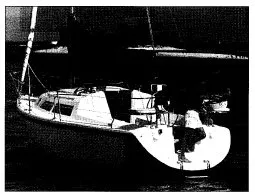
Though hard to judge in such strong, shifting winds, we think the Beneteau had the edge in sailing speed, as her statistics would indicate. Under power, however, her smaller engine and prop (single-cylinder, 9-hp., 26-CID Volvo, 15 x 12 optional folding prop) was definitely not as effective upwind as the Catalina’s (threecylinder, 18-hp, 3 7-CID Perkins, twoblade 13 x 10 prop). The Catalina’s Perkins also was smoother and quieter, despite the fact that its engine box (two removable clam-shells back to back, of fiberglass-foam sandwich construction) had no added insulation, while the Beneteau’s plywood box was lined with soft foam. Engine and shaft log access was very good on the Beneteau, superb on the Catalina.
At the moment, PHRF for the Beneteau is 168. The Catalina’s is not yet determined, but we would anticipate it will come in around the 195-205 range.
The interior layouts on the two boats are quite similar: large double berth aft galley to port next to the companionway, head opposite the galley, Ushaped dining area around a smallish table supported by the mast compression post and V-berth forward.
These overall similarities make the differences between the designs more obvious. For example, on the Catalina the entrance to the double aft is via a solid teak door, whereas on the Beneteau it is through a sliding curtain.
All berths on both boats have comfortable 4-inch cushions. The aft berth on the Beneteau measures 60″ x 77″, and you sleep parallel to the keel; the Catalina is slightly narrower at 57 inches wide, is 74 inches to 86 inches long depending on which side you’re on, and you sleep athwartships. We wouldn’t be inclined to sleep two in either aft berth, since the inside party not only doesn’t have much vertical roll-over room due to incursion of the cockpit sole, but also must crawl over the outside party to get up.
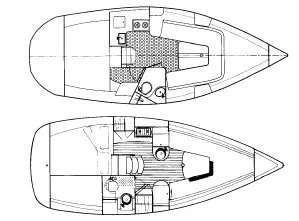
Neither the Catalina nor the Beneteau forward berths have these problems. On the Beneteau, you can lower the table and set up the berth without undue commotion; but setting up the Catalina berth involves a lot of fussy positioning of the raised forward seat and locking it in place with a pair of hard-to-reach latches. We’d like to see Catalina restudy the process to make set-up easier.
The forward berth on the Beneteau measures 19 inches at the front, 76 inches at the back, and is 88 inches long. On the Catalina it’s 10 inches at the front, 68 inches at the back, and 75 inches long. Tall folks will appreciate the larger Beneteau berth.
The Beneteau has the edge on locker space, with three separate hanging lockers (including one open-air unit in the head), and a liquor cabinet under what a Beneteau brochure describes as a nav station. In reality, there’s not enough space to unroll even a small chart on the work surface presented, which is effectively cut in two by a fiddle across its middle. Still, the “nav station” top gives the galley slave some countertop space-space sadly lacking in the galley where it should be. The Catalina also suffers from lack of sufficient galley top working space.
The use of maintenance-hungry exterior wood has been completely eliminated on the Catalina, and minimized on the Beneteau except for the companionway drop slides (King StarBoard plastic on the Catalina, nicely varnished cherry-veneer plywood on the Beneteau). Below, both boats use some wood to visually warm up the otherwise mostly white interior. The surface is totally fiberglass on the Catalina, but on the Beneteau, soft white foambacked vinyl lines the upper halves of the hull sides. If this vinyl is anything like the stuff used on boats 15 or 20 years ago, the foam backing can be expected to dry out and crumble to powder eventually.
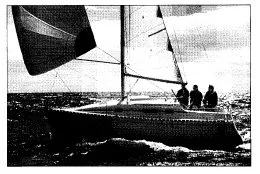
Catalina’s use of wood is sparing (varnished teak doors and trim, teak dining table, small patch of maple and teak sole forward), while Beneteau’s is lavish (varnished cherry bulkheads and trim, full teak sole). The wood is set off on both boats by neatly made upholstery on berths and settees, on the Catalina by a combination of Ultrasuede-like material and light patterned cotton fabrics, on the Beneteau by a practical and soft dark green velvet.
The Beneteau interior gives an impression of good craftsmanship, above-average but not consummately executed, and a dark though pleasantly airy cabin. On the Catalina, the impression is of a more basic, but much lighter and equally airy boat. The Catalina’s lightness is helped by a skylight of milk-white Plexiglas (two layers thick) abaft the mast, and more area in the main cabin ports. For ventilation, the Catalina has six opening ports plus a forward hatch, while the Beneteau has eight plus a forward hatch. Screens for the ports (but not for either the forward or main hatch) are standard on both the Catalina and the Beneteau. Neither boat has a rollup sunshade over the forward hatch, which would be a nice touch.
The Bottom Line
To some extent, the choice between the Beneteau 2 65 and the Catalina 270 LE is a trade off between elegant French styling on the one hand, and no-nonsense American practicality on the other. (Of interest to “Buy America” advocates is the fact that both boats are built in the U.S., the Catalina in Woodland Hills, California, and the Beneteau in Marion, South Carolina.)
The choice is also between the Beneteau’s lighter hull with quicker acceleration, and the Catalina’s equally maneuverable but heavier hull with greater load-carrying capacity and living space below.
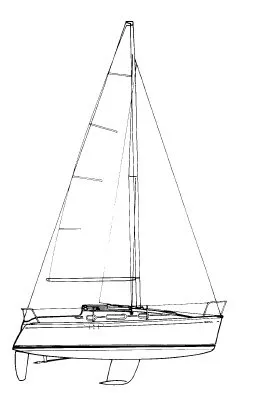
All boats are compromises, and personal taste and prejudices do enter the picture. That said, we admit to a clear preference for the Catalina. We especially like the lightness and brightness of its interior, enhanced by numerous large ports and an overhead skylight. Most of all, we like the Catalina’s greater value for the money-not just because the overall price is about 10 percent lower than a comparable Beneteau, but because of the better choice of standard items. For example, note the differences between some of the Beneteau’s items and the Catalina’s: 9-hp. raw-water-cooled engine vs. 18-hp. freshwater-cooled; no engine tach or fuel gauge vs. both standard; 8.25-gallon fuel tank vs. 14 gallons; 16.25-gallon water tank vs. 26 gallons; holding tank 11.5 gallons vs. 18; single-speed #16 self-tailing Lewmars vs. two-speed #30 STs; a 1.6- gpm Shurflo pressure water pump vs. a 2.8-gpm Shurflo pump: a gimbaled two-burner non-pressure alcohol stove vs. a gimbaled two-burner LPG stove, and so on.
Now if Catalina would only install a good-size hanging locker, put in more working counter surface in the galley, make it easier to make up the forward berth…
At a Glance
Strengths and Weaknesses
The Catalina is heavier, more stable, roomier, better equipped, and has a lower price tag. The Beneteau has more stowage lockers, faster acceleration, and French-favored rather than California favored Eurostyle. Both boats do well in heavy air. Neither is a racehorse likely to win much in competition. Neither wins the prize as the ultimate low-cost 27-footer, though the Catalina 270 (without the LE suffix) at less than $30,000, may come close.
We’d go for the Catalina without hesitation. People who are more style and performance conscious, however, may prefer the classy accouterments of the Beneteau, and fall in love with her despite its other shortcomings.
RELATED ARTICLES MORE FROM AUTHOR
Excellent comparison on both boats. I have been looking at the B & C and your article cleared up many questions I had.
Having owned a Catalina 270 for about 8 years now, and having upgraded most of the systems to reasonably current technology, we’d say this boat is a pleasure to sail. The only rea downsides are a lack of storage, (to be expected in a 27 footer) and the steering gear cover in the aft berth. It’s really annoying.
LEAVE A REPLY Cancel reply
Log in to leave a comment
Latest Videos

Bahamas Travel Advisory: Cause for Concern?

Island Packet 370: What You Should Know | Boat Review

How To Make Starlink Better On Your Boat | Interview

Catalina 380: What You Should Know | Boat Review
- Privacy Policy
- Do Not Sell My Personal Information
- Online Account Activation
- Privacy Manager
Yachting Monthly
- Digital edition

Bénéteau First 38 review: From the archive
- Dick Durham
- April 8, 2021
Though the newer Océanis range has more accommodation than the earlier First hulls, you get a lot of boat for your buck with the Bénéteau First 38, as Dick Durham discovered

The mainsheet track runs across the coachroof, out of harm’s way. Credit - Lester McCarthy Credit: Lester McCarthy
Product Overview
Overall rating:, manufacturer:.
There are Bénéteaus and Bénéteaus . Traditional sailors will cast a weather eye to the lean and hungry-looking hulls of the First series of yachts, while the comfort-seeker will be well served by the more voluptuous Océanis boats.
Certainly, the older First boats have something of the founding father of the company about them.
Frenchman Benjamin Bénéteau started off way back in 1884, building fishing boats to go offshore for the tuna shoals.
John Thompson, 57, from Albourne, West Sussex, who works in building services, sails Siesta , his 1986-built Bénéteau First 38, with his wife Ruth and occasionally their sons George and Sam, from Brighton Marina.
The family have cruised down-Channel to the West Country and across to France.
John, who used to race with top skippers, like Lawrie Smith, was a grinder aboard Victory in the 1983 America’s Cup, and is always keen to get the best performance.
Bénéteau First 38 performance

We were sorely tempted to head across the Channel to Fécamp for dinner
We left Brighton Marina in brilliant winter sunshine with a northeasterly wind of 18-20 knots apparent.
With a Spring ebb just setting westwards, we had to be careful not to get set down onto the east wall of Brighton Marina, where photographer Lester McCarthy was taking the photos for this article.
But we need not have worried: all 15 tons of Siesta can be thrown around with the dexterity of a Harrier Jump Jet.
Close-hauled, she clocked up 6.2 knots once in the groove and tacked through 90° – an angle which can be improved by 10° when she’s in racing mode.
After we put her about, the wind picked up a touch and she sped away at 7.4 knots with the wind over the quarter and we were sorely tempted to carry on to Fécamp for dinner.
When we ran off down-Channel, she made 6.5-7 knots. She will heave-to, but this takes considerable trial and error.

Life below decks on the Bénéteau First 38
Climbing down Siesta’s tight, safe companionway, the saloon is framed by the cutaway bulkhead.
The interior design has not dated, like so many of the Bénéteau First 38’s contemporaries.
The smartly upholstered headlining is fitted with wood veneer strips, giving the space a sense of perspective.
The U-shaped settee, to port, converts to a double berth with the drop-leaf table. To starboard there is a single settee berth and a small pilot berth.
The cherry and oak sole and quality finish in real timber – with plenty of grabrails and hand-holds – add to the smart, seamanlike living quarters.
The forward cabin has a V-berth with shelving each side and a hanging locker. It is adequately lit by a forehatch.
The forward heads, to port, has a shower, a rather dated-looking padded vinyl deckhead liner and a red plastic sink. Opposite the heads is a good-sized hanging locker.
The forward facing nav station, to starboard, has a huge chart table, which is well fiddled and has a deep space beneath for almanacs and charts.

The nav station has a big chart table and plenty of space for almanacs, pilot books and electronics
There is a lot of room to mount radar, VHF radio, chartplotter and other electronics, and plenty of space for navigation tools: pencils, rubbers, dividers and binoculars. It also has shelving for a CD player.
The galley is well designed, with ample worktop space, double stainless steel sinks a top-loading fridge and a gimballed, two-burner stove with an oven and a grill. There is plenty of cupboard storage space.
The headlining in the double-berth aft cabins on both sides is rather unpleasantly like a grotto I once saw in Wookey Hole: its undulating surface is cheesy-looking and drooping.

The well-designed galley has ample worktop space, a top loading fridge and a double sink
There is plenty of space, with hanging lockers, shelves, a cupboard and even a sink with double taps in both.
There is a seamanlike second heads, ingeniously installed on the centreline between both aft cabins, behind the companionway stairs and in front of the engine compartment.
Her sweet-lined and racy-looking hull is easily driven and the accommodation, while not offering the huge volume of so many modern yachts, is ample for family cruising.
It is said that Bénéteau, the world’s biggest boatbuilder, has seen more of its designs sail across the Atlantic than any other boat.
The Bénéteau First 38 is no exception. Many are sailed in the USA and more than one has made a circumnavigation.

The saloon, framed by a cutaway bulkhead, is smart and seamanlike and has not dated
Construction of the Bénéteau First 38
Her hull is hand laid over a structural grid system, which is glassed directly to the hull with floors and stringers.
The 2ft-high structure incorporates limber holes so that bilge water cannot remain trapped in one section.
The bulkheads are glassed and bolted to the hull. The deck is a balsa-cored glassfibre sandwich and the hull-deck joint incorporates the aluminium toerail.

The headlining in the double berth after cabins is rather like a grotto in Wookey Hole
Bénéteau First 38 deck layout
There’s a good-sized anchor locker, which takes a 35 lb CQR on chain and warp and there’s a shelf to fit a windlass below deck.
Her fairleads are cut into the toerail and she has cleats at bow and stern, but not amidships.
On a boat of this length, it would not go amiss for mooring springs.
She has a real teak laid deck, which John says takes less maintenance than cleaning GRP.

Her 15 tons can be thrown around with the dexterity of a Harrier Jump Jet
She has good foredeck space for changing sails and wide sidedecks.
Her low coachroof gives her a sleek look and John has removed the sprayhood: ‘Now the kids have grown up, she looks better without it.’
The mainsheet traveller is fitted to the coachroof forward of the companionway.
She has a secure cockpit: while not the deepest I’ve seen, it’s not too wide and has good line of sight ahead for the helmsman.
She has Lewmar 30 halyard winches and Lewmar 46 self-tailers for the headsail sheets. There is another pair of Lewmar 30s for the spinnaker sheets.
Siesta has a stainless steel gantry – not standard – which supports the radar, GPS aerial and a base for a wind generator.
However, John is going to remove it, as he feels it detracts from the boat’s appearance and her performance.
There is stowage beneath the humpbacked helmsman’s seat for fenders and warps, but the only other cockpit stowage is a shallow starboard-side locker.
Under power
An excellent feature of this boat is the removable cockpit sole, which allows the engine to be craned out easily if required.
She is fitted with a 50hp Perkins diesel. Going astern, there is an issue with propwalk as she has no skeg, but once under way, she steers predictably.
Going ahead, she handles well and can turn in her own length.
Yachting Monthly’s 100-point results
Performance – 10/10
As we took her through her paces she proved fast-paced, sea-kindly and highly manoeuvrable.
Many of these boats have crossed the Atlantic and at least one has circumnavigated. She can sail upwind in strong winds without any slamming.
At the helm – 9/10
Good all round vision, thanks to her low coachroof. She has a balanced spade rudder which gives excellent control, especially downwind.
But without a protective skeg the blade is always exposed to potential damage.
Deck layout- 7/10
An amidship cleat would have been an advantage. There’s even a fairlead amidships in the aluminium toerail. Her headsail sheet tracks are well inboard for close-winded work. Her cockpit is on the shallow side but feels secure.
Sailplan – 8/10
The masthead rig takes a large genoa (48.50m2) which is a handful in a breeze.
She carries a vast spinnaker (109m2) which you probably would not consider setting if short-handed. Her reefing system requires one crew on deck.
Design & construction – 9/10
She’s a great boat to look at with her fine ends and sweeping sheer. She is also well built and unsparingly laid up. Her iron keel is connected to bolts which are incorporated into the hull liner.
Maintenance – 8/10
The shroud plates are exposed in the saloon. Brilliant access to the engine all round: from the aft head, both aft cabins and via the cockpit sole.
The teak deck caulking needs work sometimes but John prefers tending to this than cleaning GRP.
Chart table – 9/10
The chart table is a traditional, forward-facing nav station with good bracing positions and plenty of room for mounting instruments and stowing pilot books.
Galley – 8/10
The galley is on the small side but it works well in a seaway.
This is a cooking area made for a boat which is likely to make serious passages.
Therefore food under way is more important than culinary efforts in port.
Heads – 9/10
The one area of the boat which is seriously dated. But forgetting the look, the space is adequate.
I liked the ‘hidden’ heads aft: from where you access the front of the engine.
Living below – 9/10
She is well thought out and comfortable, both at sea and in port.
There are plenty of grabrails and hand-holds. She sleeps up to 10 crew at a push, but nine comfortably.
First published in the February 2011 issue of Yachting Monthly
From the moment you lay eyes upon her racy shape, powerful hull and lofty rig, you know you are looking at a thoroughbred. This boat will take you anywhere, safely and at speed. For the price, she’s one of the best buys on the second-hand market.

- Forums New posts Unanswered threads Register Top Posts Email
- What's new New posts New Posts (legacy) Latest activity New media
- Media New media New comments
- Boat Info Downloads Weekly Quiz Topic FAQ 10000boatnames.com
- Classifieds Sell Your Boat Used Gear for Sale
- Parts General Marine Parts Hunter Beneteau Catalina MacGregor Oday
- Help Terms of Use Monday Mail Subscribe Monday Mail Unsubscribe
Beneteau Quality?
- Thread starter Robert
- Start date Feb 24, 2006
- Beneteau Owner Forums
- Ask A Beneteau Owner
Was not too impressed with the quality/workmanship of these new production boats. Was at a boat show and noticed the deck of brand new 36.7 was real thin. Don't beleive me?...just rap your knuckles on them. There was no core. It was just a 1/2" of glass topped with gelcoat. I think that 5 years from now, owners will be lined up to complain about the workmanship. Would like to hear from Beneteau owners with their comments about the quality. I really like the look of their boats but am quite concearned with the longevitity and future value of investing in a Beneteau. I want to hear from Beneteau owners about their quality issues....
Bill C320 Papillon
Love my 10 year old 281. Haven't had any real problems anywhere. Walk all over the deck and it's very solid. I only weigh about 190# so if you're big, maybe you'll feel some give.
Short rant I sure get sick of all this talk about "thin fiberglass." Do you think these BOC or Volvo race boats are layed up like a Westsail?? Go check out a J Boat. Modern glass techniques means the hull and deck don't have to be 2" thick anymore -- and weigh 20 tons.
Trevor - SailboatOwners.com
Deck thickness Rarely have I ever heard of "thin decks" being a quality issue. They are designed for the purpose of the boat. Perhaps the boat in question is a but light for your expectations but under extended stress the more likely scenario would be moving bulkheads, chain plate leaking, etc - not decks that will crack. Other potential issues are deck voids where air is trapped between layers which would need to be injected with epoxy for a proper fix. I used to work in warranty for a Beneteau dealer, so am familiar with their newer boats. That being said, I have never owned a Beneteau, so I am speaking in broad terms only. Best, Trevor
Cored Deck I just cut a 3" hole trough the cabin house deck of my Beneteau 331 Oceanis to install a cabin heater vent. The deck is very well constructed. About 1/2 fiberglass laminant outside with a 3/4 inch wood core and then 1/4 inch of glass laminant inside and then the overhead liner. I am quite sure that it will out last me (I am 54 years old).
Are you out of your mind? It is apparent that you have an axe to grind. Anyone who has been aboard a Beneteau would know that the decks are sound, the finish and fit is in accordance with, or superior to, industry standards. Opening any hatch and reaching in with a thumb and forefinger would measure the thickness of the deck. It is evident that Robert never bothered to do this. It is evident that he never walked on the deck. If he had done either, he would know that the deck thickness far exceeds his estimation. A 1/2" deck would deflect under the weight of a fairly small individual. An uncored deck of the indicated thickness would manifest itself throughout the vessel in a very negative way. The winches and other deck hardware would not last long without a core to spread the load. Your previous querries have generated no negative quality problems with Beneteaus so..........the question I ask you is: "Why do you persist in you defamation of a fine boat?"
Good Quality - Not Great...Just Good Beneteau make good boats. Their quality is not superb but they make good boats that average folks can afford. Their standards are high and for the money they are just fine. If you want to buy a better vessel then you can pay alot more for it and be satified that you might have something that is better...but not much.
Phil Herring
t3 t3
Bob Brancaccio
Quality I'm in the process of commissioning my 1986 First 305 which is 20 years old this month. The topesides, deck and interior look as good as the day I bought her. This is after many cruises and hard racing.
quality of beneteaus Like you, I have not been impressed with the quality of construction on recent model Beneteaus. My first clue was walking on the cabin sole of virtually all B's at a recent boat show - the soles all felt like we were walking on a trampoline. Some of the other concerns I noticed were - raw fiberglass inside and behind lockers - could easily have been finished properly; chopped strand mat pattern (i.e, random pattern) showing through the gell; plastic (marlon?) thru hulls rather than bronze; most boithersome were some of the basic construction faults apparent around the hull, not the least of which were deck joint voids and lack of uniform tabbing of bulkheads. I have beena loyal B owner for 20 years, raced on some and did the Newport/Bermuda last year on a 40.7 my son ownes but I'd never buy a new one. Please no retaliatory personal attacks - they are childish.
Sailed to Bermuda in a boat you think is cheap? You sailed a 600 mile race offshore in a boat you wouldn't buy yourself? DOESN'T THAT SEEM FOOLHARDY? I disagree on all counts. I have pacific offshore experience and have prepared my 361 for same. I have spent much time looking into these matters. Structural grids, quality hardware etc. The quality IS there. It's not indestructible and nor perfect. Yes there are some flaws here or there, but those same flaws exist in most boats. If they don't my bet is it cost twice as much or more as the Beneteau. The resolution of this matter is that there are different boats for different folks. If you want to put all your money into a perfect boat, you won't be able to enjoy it. Get the best boat for the money that is safe, seaworthy, fast, comfortable, satisfying etc. Beneteau has likely learned something since you first bought one 20 years back, don't you think? The public at large seems to think they are doing a pretty good job as they are selling their boats pretty successfully. People are also racing them to places like, oh,....................................................Bermuda! Another won its division in Transpac. A B44.7 won in Sydny Hobart. Come on, give us a break. If the rigors of racing don't testify to the quality, I don't know what does.
Don't be Childish Paul, Stop being childish and messing with Donald. He is obviously an expert and should be given your respect. He is smarter than you and simply won't be suckered into buying a crappy boat.
- This site uses cookies to help personalise content, tailor your experience and to keep you logged in if you register. By continuing to use this site, you are consenting to our use of cookies. Accept Learn more…
- 2024 BOAT BUYERS GUIDE
- Email Newsletters
- Boat of the Year
- 2024 Freshwater Boat and Gear Buyers Guide
- 2024 Boat Buyers Guide
- 2024 Water Sports Boat Buyers Guide
- 2023 Pontoon Boat Buyers Guide
- Cruising Boats
- Pontoon Boats
- Fishing Boats
- Personal Watercraft
- Water Sports
- Boat Walkthroughs
- What To Look For
- Best Marine Electronics & Technology
- Watersports Favorites Spring 2022
- Boating Lab
- Boating Safety

Beneteau Boats
By Jeff Hemmel | March 2023
Learn more about Beneteau boats by viewing our extensive collection of boat tests, reviews and other related content. Boating-exclusive content is produced by expert, longtime boating enthusiasts with extensive knowledge of the boating industry. Whether you’re looking to buy, sell or just research the brand, our content is here to help.
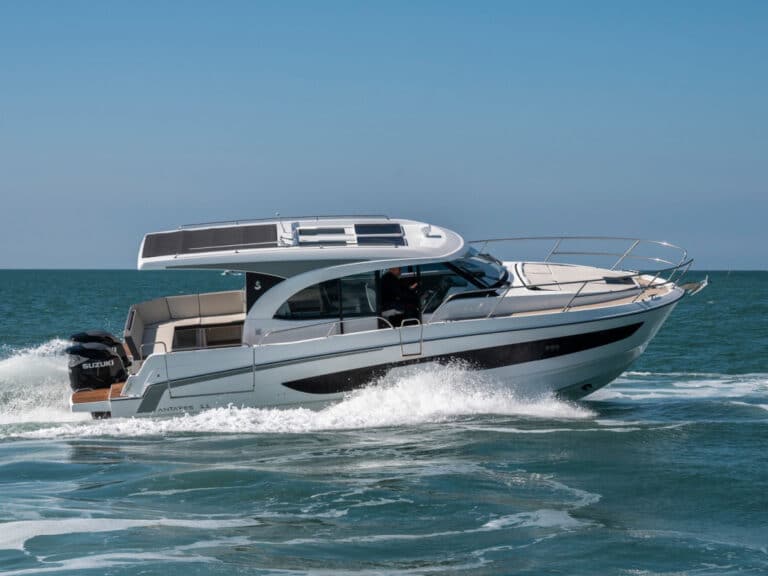
Beneteau is one of Europe’s oldest boat builders . Founded in 1884 by Benjamin Beneteau in the French port city of Croix-de-Vie, early fishing-oriented boats were designed with two goals — to be durable enough to handle the North Atlantic waters and fast enough to be first back to shore with the day’s catch. Today, Beneteau is still known for these core traits but has evolved from the builder’s early commercial-fishing roots to become one of Europe’s leading builders of recreational power and sail boats. Powerboat models include the Flyer range of day boats from 21’ – 34’, Antares outboard-powered cruisers from 24’ – 36’, Gran Turismo express cruisers from 32’ -48’, long-distance Swift Trawlers from 37’ – 48’ and the flagship 62’ Grand Trawler .Power options span from gasoline-powered outboards to gasoline and diesel-powered sterndrives, diesel inboards and Volvo Penta’s IPS Inboard Performance System .
On this page:
Quick overview.
- Types of Boats
- Boat Tests & Reviews
Beneteau currently produces a variety of models divided between the day boat, cruiser, express cruiser and trawler categories.
Types of Beneteau Boats
Beneteau manufacturers a variety of both power and sail boat models. The Powerboat line includes Flyer day boats from 21’ – 34’, Antares outboard-powered cruisers from 24’ – 36’, Gran Turismo express cruisers from 32’ -48’, long-distance Swift Trawlers from 37’ – 48’ and the flagship 62’ Grand Trawler .
- Available in both open-bow and enclosed-bow designs from 21’ – 34’, the Flyer range of dayboats is designed with cruising, performance, entertaining and watersports in mind.
- Enclosed-bow SUNdeck models offer sunbathing lounges topside and cabins with berths, toilets or enclosed heads, and galley variations below.
- Open-bow SPACEdecks maximize passenger space with forward bow seating that converts to a roomy sunpad, cockpits that focus on cruising or fishing and, on larger models, open cabins with toilets and modular cockpits to enhance socializing.
- Models include Flyer 7 SPACEdeck , Flyer 7 SUNDeck , Flyer 8 SPACEdeck , Flyer 8 SUNdeck , Flyer 9 SPACEdeck , Flyer 9 SUNdeck and Flyer 10 .
- Six models from 24’ – 36’, the Antares line of cruisers includes the Antares 7 , Antares 8 , Antares 8 Fishing , Antares 9 , Antares 11 and Antares 11 Fly .
- Each is defined by an enclosed pilothouse , inviting cabin, flared hull and outboard engine power.
- Models include traditional weekend cruiser designs as well as flybridge and fishing-focused models .
- Highlights include open-feeling wheelhouses with large salons , below-deck cabin with seating that connects to forward berths, enclosed head compartments with toilet and shower, and galleys with refrigerator sink and stove.
- Sleek express cruisers from 32’-48’, Gran Turismo models include the Gran Turismo 32 , Gran Turismo 36 , Gran Turismo 41 and Gran Turismo 45 .
- Common style elements include a recessed forward deck with sun lounges to soak up the rays, hardtop-covered cockpit with large window to maintain a bright and open feel, and open aft cockpit area that can be used for seating, entertaining or sunbathing.
- Below deck, roomy cabins include a forward berth/dinette, mid-cabin berth, galley and enclosed heads.
- Depending on size, power options extend from twin outboard or twin sterndrive configurations to Volvo Penta’s Inboard Performance System (IPS) .
- Designed with the long-distance traveler in mind, Swift Trawlers — including the Swift Trawler 35 , Swift Trawler 41 Fly , Swift Trawler 41 Sedan and Swift Trawler 48 — are seaworthy vessels that combine safety and stability with comfortable accommodations.
- Styles include traditional , flybridge and sedan models.
- Topside, enclosed wheelhouses pair with main salons that offer aft galleys and abundant passenger seating. The latter often doubles as sleeping space.
- Below deck, as many as three cabins combine with up to two enclosed head compartments and shower to guarantee a comfortable excursion.
- Power is provided by a choice of shaft-line drives from Volvo Penta .
- The ultimate flagship in Beneteau’s trawler family, the Grand Trawler 62 provides passengers luxurious accommodations no matter how long the voyage.
- A large flybridge includes wetbar and table seating. Below, the wheelhouse is matched with large galley, dining area and salon.
- Below deck, the guest cabin in the bow and midship owner suite take full advantage of the boat’s generous beam for hotel-like room. Or, reconfigure the layout to create as many as four cabins and multiple head compartments.
Beneteau Brands
In addition to the Beneteau line, Group Beneteau owns the Jeaneau, Prestige, Delphia, Four Winns, Wellcraft, Scarab, Glastron and Monte Carlo Yachts brands.
Builders of upscale yachts, cruisers , dayboats and fish/dive-friendly center-consoles.
A luxury-minded lineup of multi-hull motor yachts from 48’-65’ and V-hull models from 42’ – 72’.
Four Winns builds a variety of open bow sport boats , including sterndrive and outboard-powered bowriders from 20’ – 30’, hybrid deckboats from 22’ – 26’, and a Surf series from 22’ – 26’ powered by forward-facing sterndrives.
Once known for go-fast speedboats , today Wellcraft produces a line of outboard-powered center consoles from 20’ – 35’.
Scarab produces a line of performance-minded, open-bow sport boats and a single center-console, all powered by Rotax jet-propulsion engines. Models span from 16’ – 25’.
Glastron produces a broad range of bowriders , deck boats, and wake surf-specific models ranging in size from 19’ – 24. Power options include outboard, sterndrive and wake-surf-friendly, forward-facing sterndrives.
Boat Tests & Reviews
As the most trusted source of boating information on the internet, Boating Magazine has produced in-depth reviews of over 10 Beneteau boats . These tests are conducted by an expert staff made up of true boating enthusiasts. Tests and reviews include not only performance testing and passenger amenities, but also dig deep into a boat’s construction, handling, and overall safety .
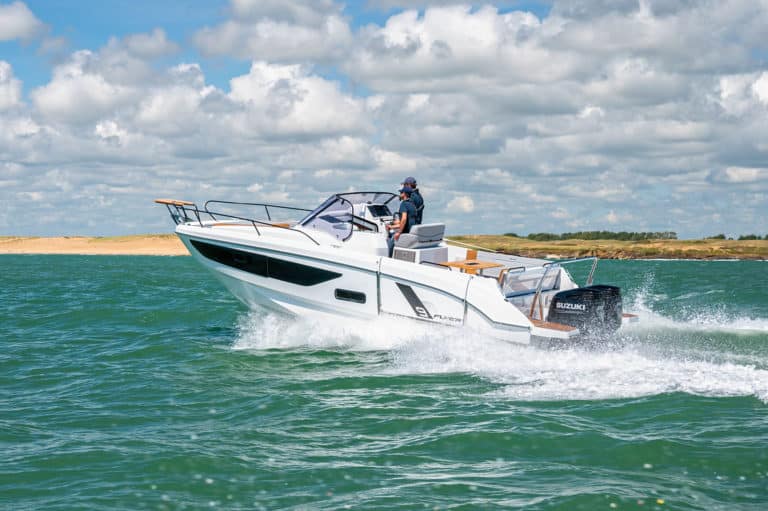
More Beneteau Boats >>
Group Beneteau Videos
Boating Magazine has produced a variety of reviews of Group Beneteau boats. Video adds another element to any boat review, allowing viewers to see and experience a boat’s features firsthand. Video reviews are hosted by Boating’s same expert editorial staff , enthusiastic boaters themselves who know what to look for in a boat…and how it will improve a viewer’s boating experience.
Beneteau Boat Tests
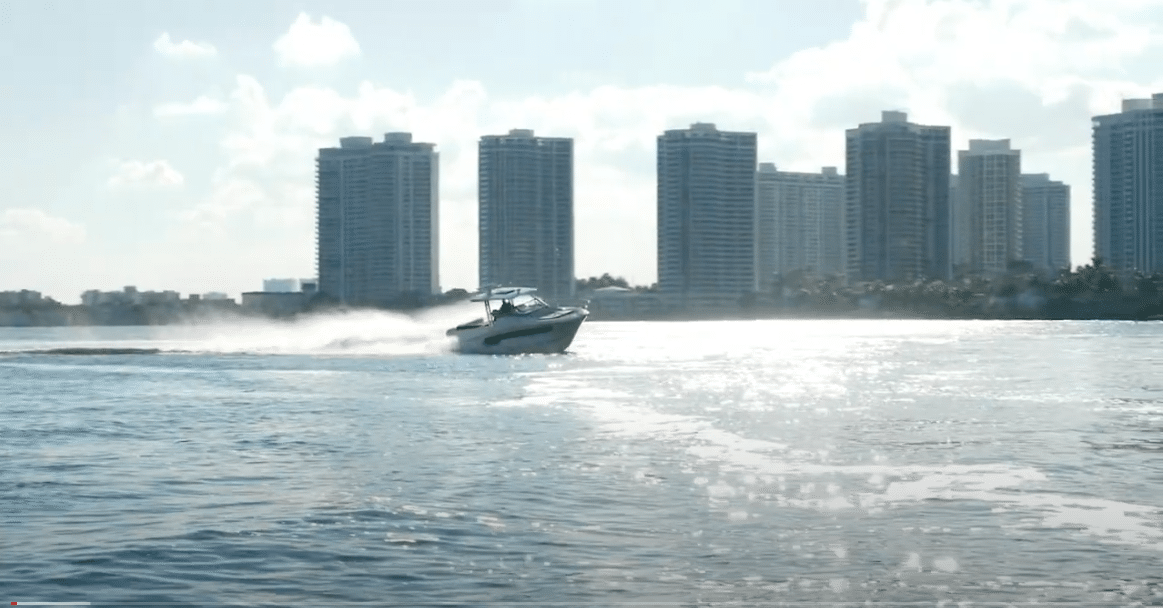
Boat Test: Jeanneau Leader 10.5 S2

2022 Four Winns H4

2023 Scarab 255 ID
Faqs about beneteau boats.
Find the answers to frequently asked questions about Beneteau boats, including the types of boats Beneteau makes, where they’re produced and how to find a Beneteau boat that fits your needs and lifestyle.
Beneteau builds a diverse list of models, divided between the day boat, cruiser, express cruiser and trawler categories.
Powerboat models include the Flyer range of day boats from 21’ – 34’, Antares outboard-powered cruisers from 24’ – 36’, Gran Turismo express cruisers from 32’ -48’, long-distance Swift Trawlers from 37’ – 48’ and the flagship 62’ Grand Trawler.
Beneteau is headquartered in Saint-Gilles-Croix-de-Vie, France. The company operates multiple factories in the country and in the United States.
Beneteau boats use a variety of engines, including single and twin gasoline outboard configurations, gasoline and diesel sterndrives, diesel inboards and Volvo Penta’s IPS (Inboard Performance System).
Beneteau offers a manufacturer’s warranty covering structural issues for 7 years and parts and labor for 3 years. For more details visit beneteau.com .
Yes, Beneteau boats are easy to maintain. Basic maintenance, including washing and waxing the fiberglass hull , keeping engine compartments clean and dry, and cleaning and using protectant on vinyl surfaces will keep a Beneteau boat looking and performing like new for years to come. Boats left in the water should have hulls cleaned yearly to remove marine growth; anti-fouling paint on submerged areas of the hull should also be applied. Follow the manufacturer’s recommended maintenance schedule, including yearly engine service, to ensure reliable, safe operation. Factory-recommended service should be performed at an authorized Beneteau dealer.
Beneteau’s Flyer line is designed with recreational watersports — including inflatable tubing, waterskiing and wakeboarding — in mind. Beneteau’s Airstep hulls provide quick acceleration and skiing-friendly top speeds. Amenities include aft tow bars that raise the towrope over the boat’s outboard engine, easy access to aft swim platforms and deep-water reboarding ladders.
Beneteau has a vast dealer network spread over five continents. Find your local Beneteau dealer here .
How to Care for a Beneteau
How to properly flush your boat’s motor.
How to run inboard, outboard and sterndrive engines on land.
How to Maintain a Boat’s Trim-and-Tilt System
How to care for your outboard’s trim-and-tilt system.
Marine Transmission Care Tips
Eight tips to help you properly maintain a marine transmission.
Tools for Drying Your Boat
Easily dry your boat promptly after each wash.
How to Wash a Boat
These tips will turn your boating chore into a labor of love.
How to Keep Boat Upholstery Looking New
10 ways to keep marine vinyl upholstery looking like new.
Explore Other Brands
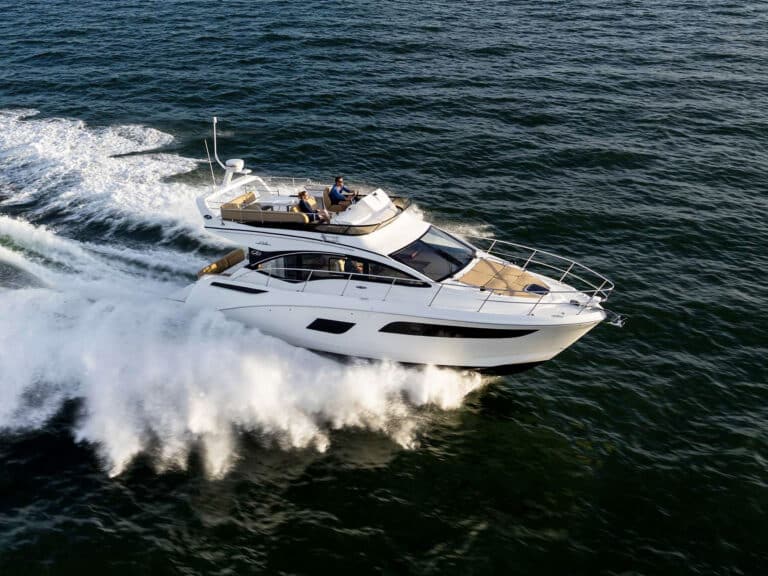
Cruisers Yachts
View More >>

- Digital Edition
- Customer Service
- Privacy Policy
- Cruising World
- Sailing World
- Salt Water Sportsman
- Sport Fishing
- Wakeboarding
Many products featured on this site were editorially chosen. Boating may receive financial compensation for products purchased through this site.
Copyright © 2024 Boating Firecrown . All rights reserved. Reproduction in whole or in part without permission is prohibited.
- AROUND THE SAILING WORLD
- BOAT OF THE YEAR
- Email Newsletters
- Best Marine Electronics & Technology
- America’s Cup
- St. Petersburg
- Caribbean Championship
- Boating Safety

Beneteau First 36, Sailing World 2023 Boat of the Year
- By Dave Reed
- December 16, 2022
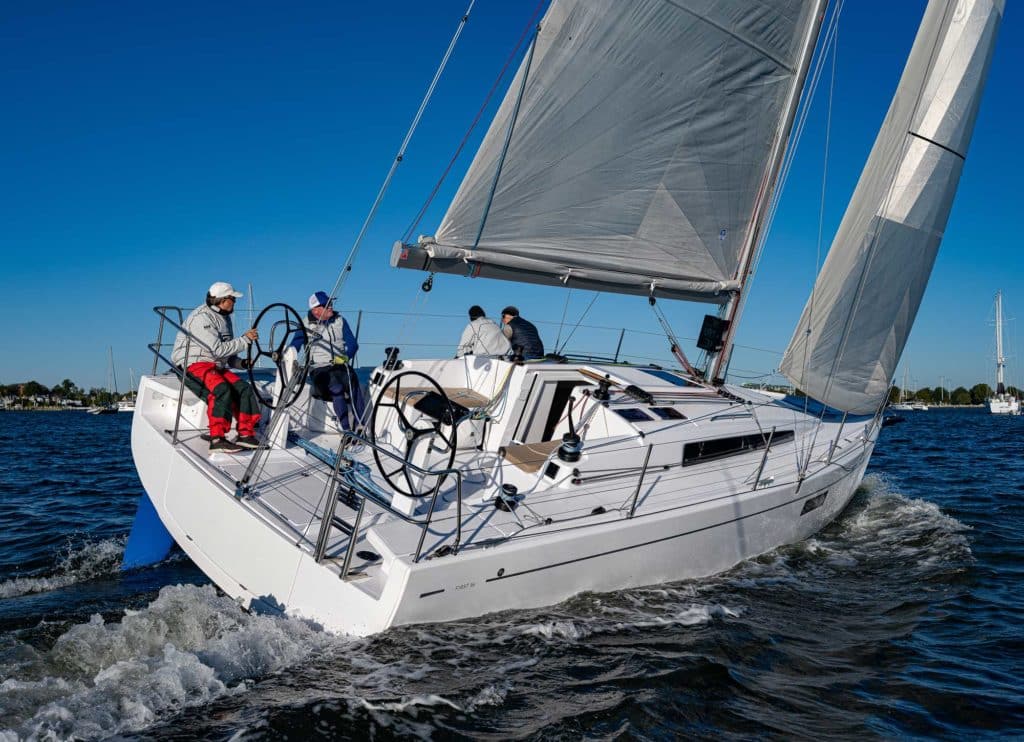
Sailing World Magazine’s annual Boat of the Year tests are conducted in Annapolis, Maryland, following the US Sailboat Show. With independent judges exhaustively inspecting the boats on land and putting them through their paces on the water, this year’s fleet of new performance-sailing boats spanned from small dinghies to high-tech bluewater catamarans. Here’s the best of the best from our 2023 Boat of the Year nominees »
The Total Package
- Beneteau First 36 2023 Boat of the Year
- Stated purpose: Shorthanded racing, club racing, coastal cruising
- Crew: Solo to six
- Praise for: Build quality, deck layout, versatility
- Est. price as sailed: $345,000
Like a runaway, the Beneteau First 36 careens across a westerly-whipped Chesapeake Bay. The boat’s big-shouldered spinnaker and mainsail are silhouetted in the early October morning light. It’s making trees on the Eastern Shore as we peg the throttle down to keep chase in a 19-foot RIB. The four crewmembers on board are having a casual conversation—like no big deal—when a cold and meaty gust fills the spinnaker. The leech flickers, and the boat surges forward onto plane. Twin rudders zipper the slick streaming out from the transom as the helmsman, hands at 10 and 2 on the carbon steering wheel, effortlessly weaves the boat across waves tops. The boat is, as the saying goes, on rails.
“Wicked,” is how senior Boat of the Year judge Chuck Allen summarizes his experience when he steps off. “That boat is going to be hard to beat.”
Three days and 10 boats later, nothing comes close to usurping the Beneteau First 36 as the obvious and unanimous Boat of the Year, a boat that has been a long time coming and overdue. It’s a boat that will serve many masters.
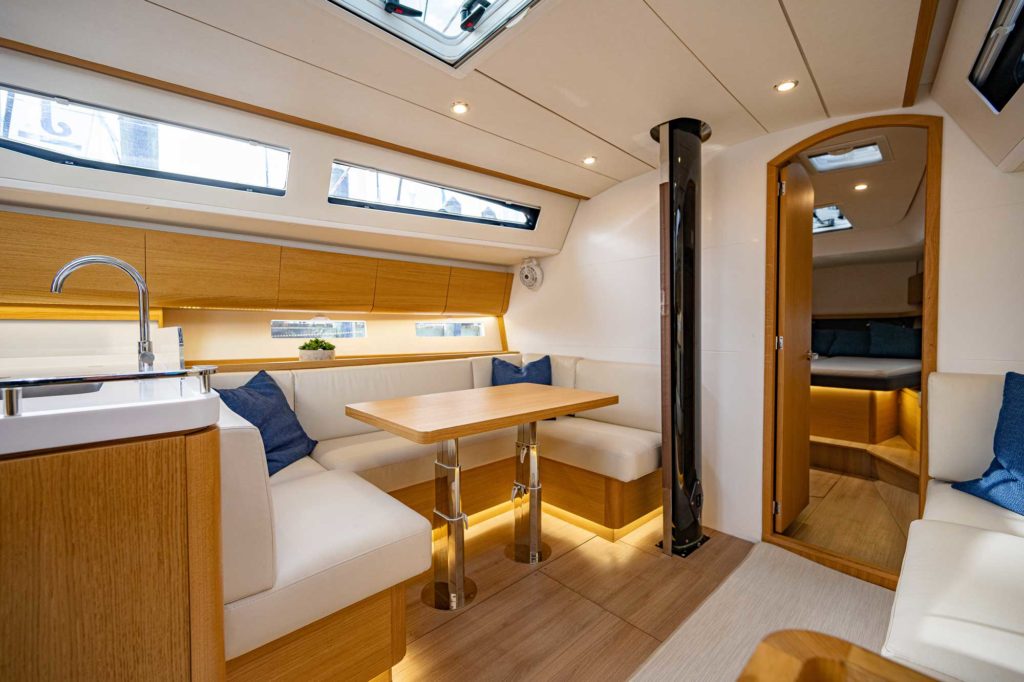
Beneteau initiated its First 36 project in 2019 by surveying a broad focus group of First “Point 7” owners and dealers about what they wanted in the marketplace, and the takeaways were: 1) Not another displacement boat—it had to plane. 2) They wanted a lounge, not a dining room. 3) They wanted their nav station back, and 4) for that, they were OK with having a smaller head.
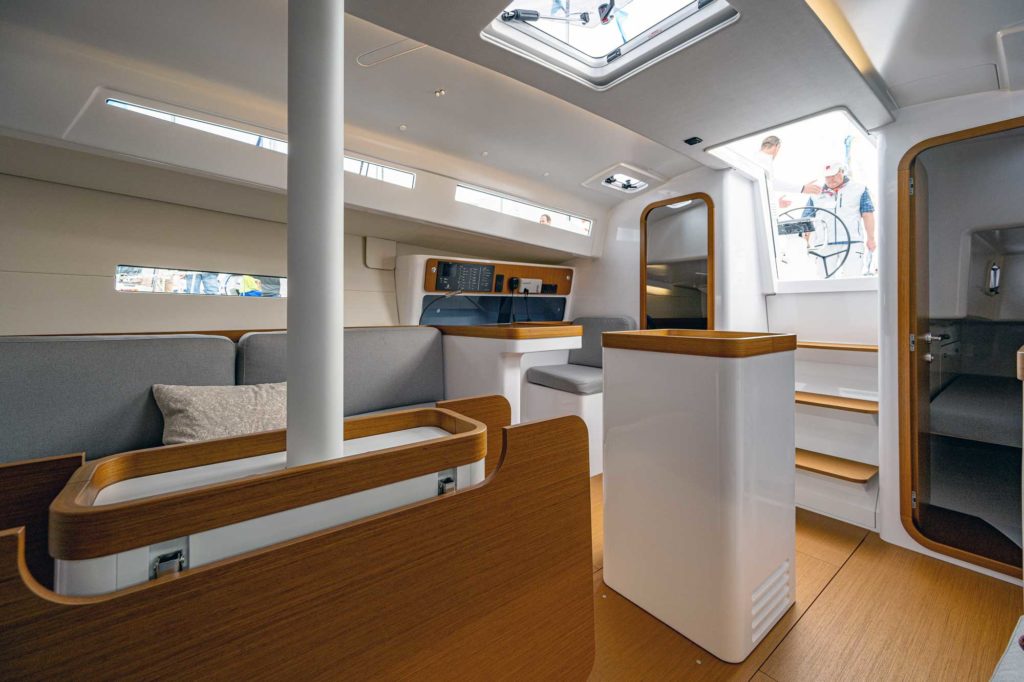
Given the boat was to meet all three of its club racing, shorthanded and cruising demands, the brain trust assembled inside and outside of Beneteau focused on No. 1—keeping it light and fast. Naval architect Samuel Manuard, the new hot talent of the IMOCA 60 and Class 40 scenes, did the hull, keel and rig. Pure Structural Engineering took care of the structure, and the weight-obsessed glass slingers at Seascape’s factory in Slovenia ensured the boat came in at not a pound more than 10,580. At that weight, of course it’s going to plane.
The entire boat is vacuum-infused with CoreCell (hull) and PVC (bulkheads) from the deck down, inside and out, and everything, except the fridge, is somehow a piece of the structure puzzle.
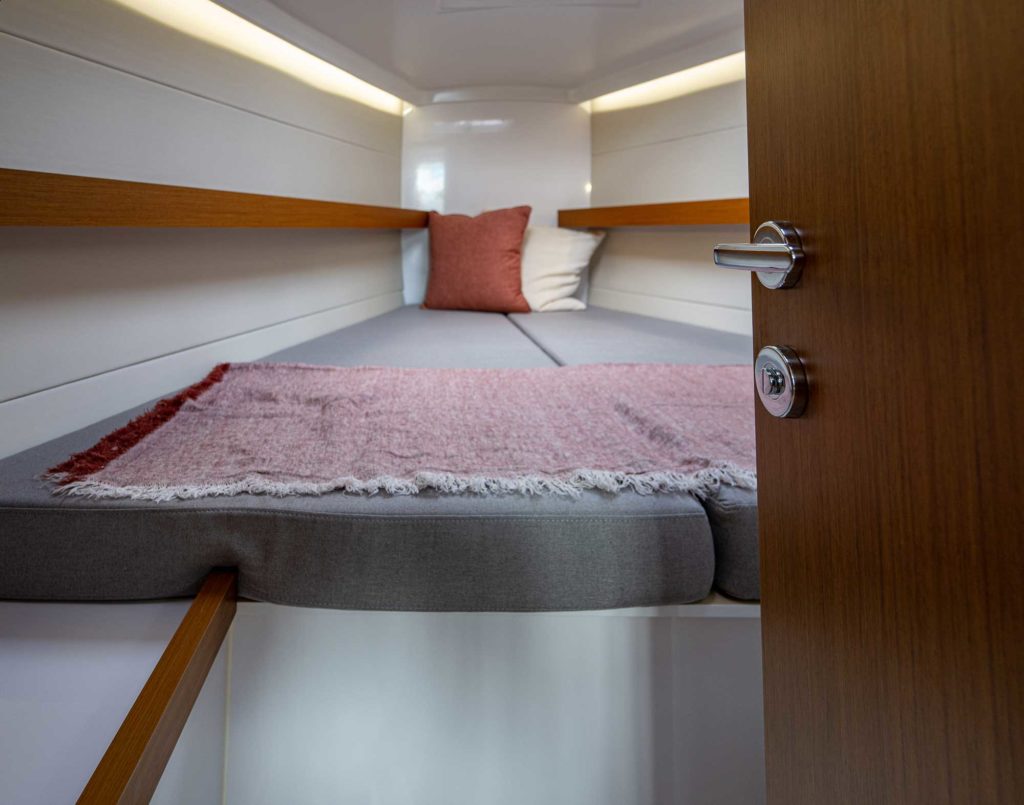
“We are saving big weight there, as furniture is also part of the structure, and all of it glued together makes the boat extremely stiff and very light,” says Beneteau’s Tit Plevnik. “What is special is how calculated it is. In mass-production building, you can’t rely on precision, but we do. The boat is built to the same standard as a pure racing boat.”
“The moment I saw it, I knew it would be good. It’s a great-looking boat at the dock and even better with the sails up.” —Greg Stewart
Built like a race boat, the judges all agree it sure sails like one. “It’s a big 36-footer,” says veteran BOTY judge and naval architect Greg Stewart. “It’s a full-ended boat that has a hint of a scow-type bow with a lot of buoyancy forward. Looking at the numbers, what they achieved with the weight and its placement is impressive—10,000 pounds for a 36-foot waterline length is a very good number. I could tell the minute we put the spinnaker up it was a slippery boat.”
Stewart set the day’s top speed at a tick over 18 knots and says: “I remember feeling the puff hit and load the rig, and the boat just scooted off with really nice steering. It felt like a Laser when you get it in that groove and it just levitates. With the dual rudders, which are pretty long, the boat has more of a power-steering feel upwind, so it lets you do a lot of things. There’s so much control, which is a good thing because you can drive out of situations, but at the same time, it’s easy to oversteer.”
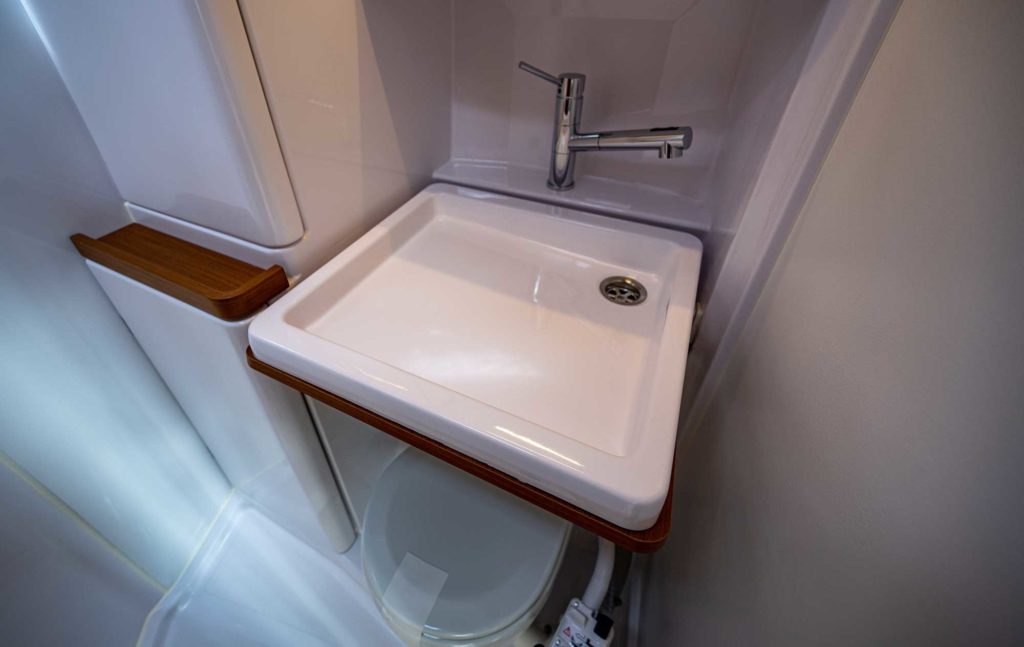
Multiple cockpit mock-ups done at different heel angles produced a workspace that the judges could find no flaw with. “It’s all legit, easy and clean in the pit,” Allen says. “With the four of us in the cockpit, we had plenty of space to move around and were never into each other.
“I was doing a lot of trimming downwind,” Allen adds. “You can feel the boat take off. It was really stable and easy to handle. The thing is light and fast, and we did push it to try and wipe it out, but it was hard to do.”
All the judges praised the clever location of the primary winches on sloped coamings, which were easier to trim from than a traditional winch-on-the-coaming setup. “They’re at the perfect height,” says judge Dave Powlison, “and with them angled like that, you don’t have to crane your neck to see the sail, and the lead is virtually override-proof.”
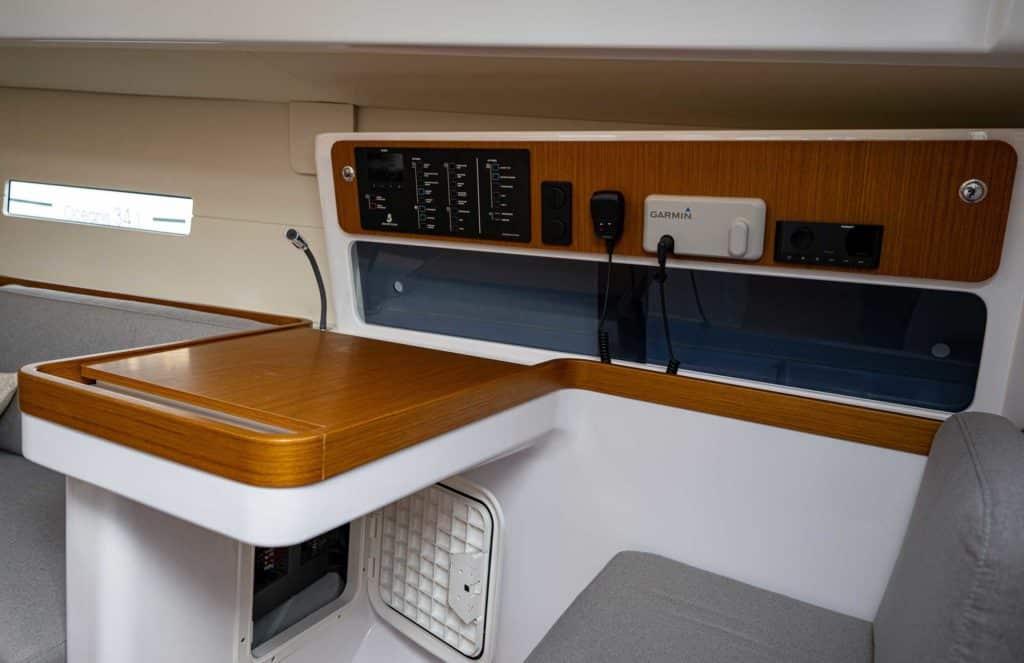
Also noteworthy is the generous space between the high carbon wheels and the cockpit walls that allow the helmsman to slide forward without having to step up and around the wheel. The jib trimmer has easy access to the three-dimensional clue adjustment systems, and for the pit, there’s plenty of clutches, redirects and cleats to keep everything sorted and tidy.
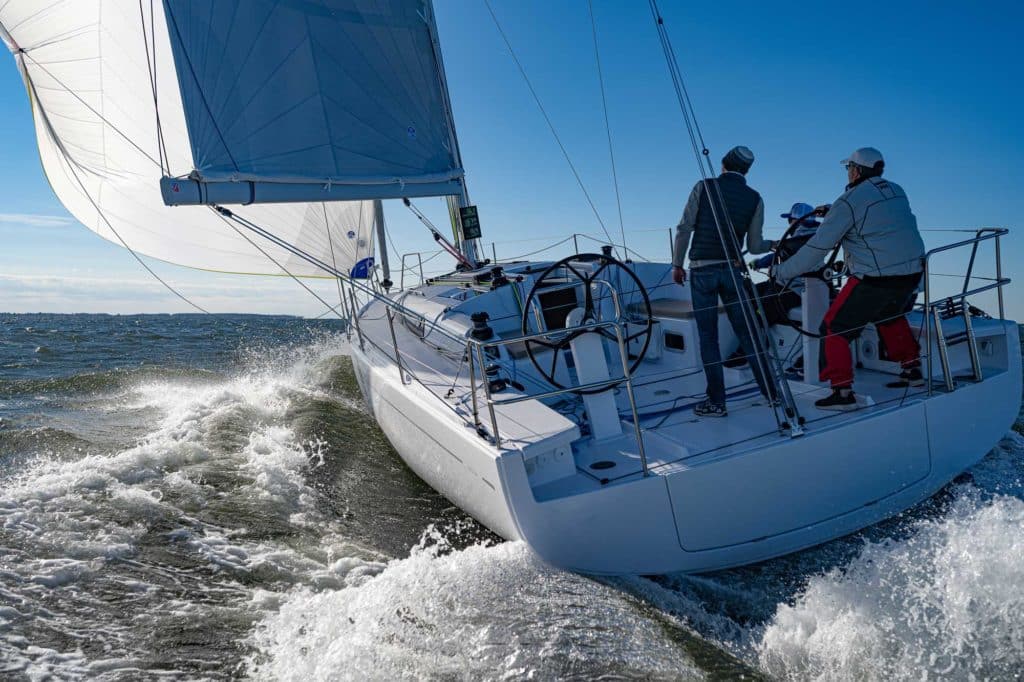
The standard spar, and that on the demo boat, is a deck-stepped Z Spars aluminum section with Dyform wire rigging that carries 860 square feet of upwind sail area, which Stewart says is considerable for the displacement of the boat. The mast is well aft, which really stretches out the J dimension and opens the foredeck for a quiver of headsails—for this, you’ll find two tack points on the foredeck. There are four halyards total: one for a masthead gennaker, a 2-to-1 for a code sail, a fractional gennaker, and a 2-to-1 staysail. Allen, a semi-retired sailmaker, put an estimate for a complete race inventory at $60,000, which would put the boat on the racecourse for roughly $400,000. (Base boat is priced at $345,000.)
When the race is done, however, how about that interior?
Step down the wide companionway steps into a space of design simplicity and efficiency, some of which makes you say, “Duh, of course.”
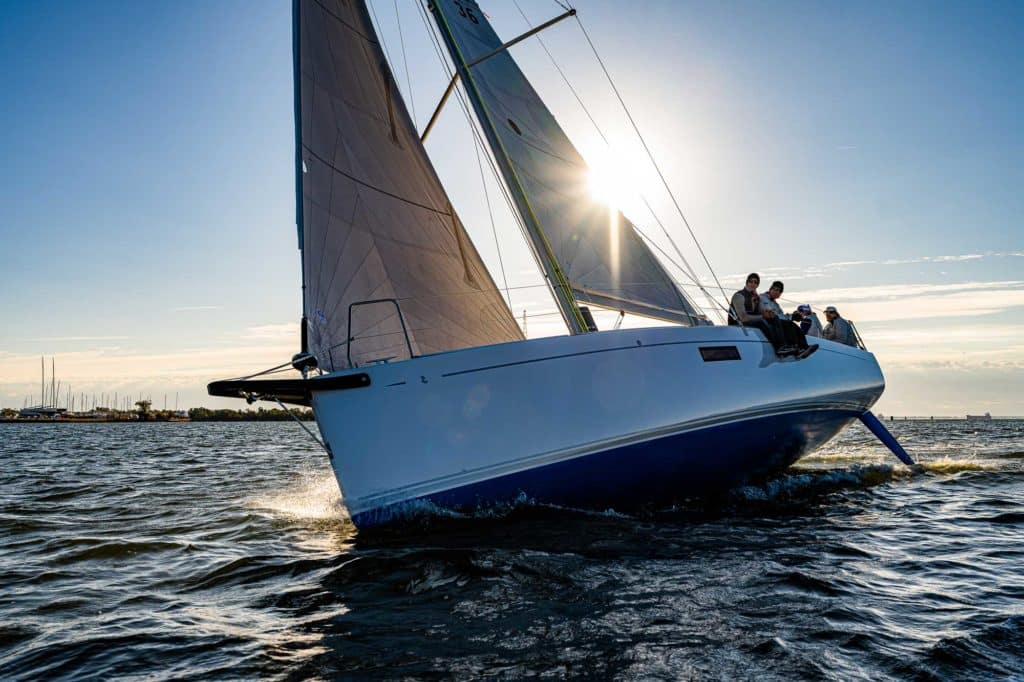
For example, there’s no traditional L-shaped galley to port or starboard. There is, however, a tall and slender fridge smack in the middle of the boat (that you connect to the galley with a removable cutting board to complete the L). Walk on either side of it to get forward, past the proper nav station, the fold-down dinette table in the middle with roomy 6-foot berths on both sides, a jetliner-size head with a stowaway sink to starboard, and then a gigantic V-berth that benefits from all that volume in the bow. Back aft, under the cockpit, are large quarter berths as well that easily cruise-convert into storage space for water toys, like kites, wings and foils, all of which takes us back to survey result No. 2. This is where the post-race party begins and ends.
With the usual supply-chain delays, compounded with the build and design team’s obsessive and calculated approach to getting the Beneteau First 36 perfect at Hull No. 1, its debut got off to a later start than hoped. But with early boats landing at eager dealers worldwide, Plevnik says the goal is 32 boats per year for the next two years. The BOTY judges assure us it’ll be worth the wait and give you plenty of time to start planning what you can and will do with it.
- More: 2023 Boat of the Year , Beneteau , Boat of the Year , Print Winter 2023 , Sailboats
- More Sailboats

Nautor Swan Has A New Pocket Rocket

Pogo Launches its Latest Coastal Rocket

A Deeper Dive Into the Storm 18

2024 Boat of the Year Best Recreational Racer: Z24

Brauer Sails into Hearts, Minds and History

Anticipation and Temptation

America’s Offshore Couple

Jobson All-Star Juniors 2024: The Fast Generation

- Digital Edition
- Customer Service
- Privacy Policy
- Cruising World
- Sailing World
- Salt Water Sportsman
- Sport Fishing
- Wakeboarding
Beneteau Build Quality
You’re not just buying a boat with Beneteau. You’re buying a trusted brand which has become world renown for perfecting it’s build process and delivering to the highest standard. They’ve tried and tested their methods over 130 years in business to offer the highest quality to value ratio on the market, and this gives you complete peace of mind when making your order.
BoatTest.com’s Christopher Hugh sums it up when he says; “the level of detail applied to quality assurance was one of the highest I have witnessed in more than the 160 factories I have visited around the world,” following his visit to Beneteau manufacturing facilities in France.
How is Quality Assured?
There are many phases involved in constructing each boat, and Beneteau has perfected every single area through years of extensive research and development. This means that each Beneteau is crafted with the most durable, efficient, and cost effective materials on the market.
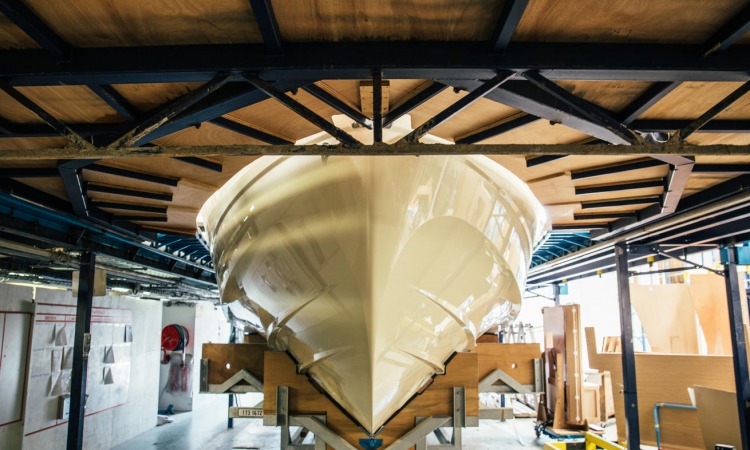
High End Materials
The high end Balsa core is just one of them, and is used as a sandwich laminate between fiberglass to make the hulls of the desired structure and strength. While the design team creates the admired hard chined hull shapes of their yachts, the production team pulls through on making them perfect every time with materials that are light weight and durable. Each new build is thoroughly tested to ensure it meets every standard, and the buyer is kept informed during each step of the process.
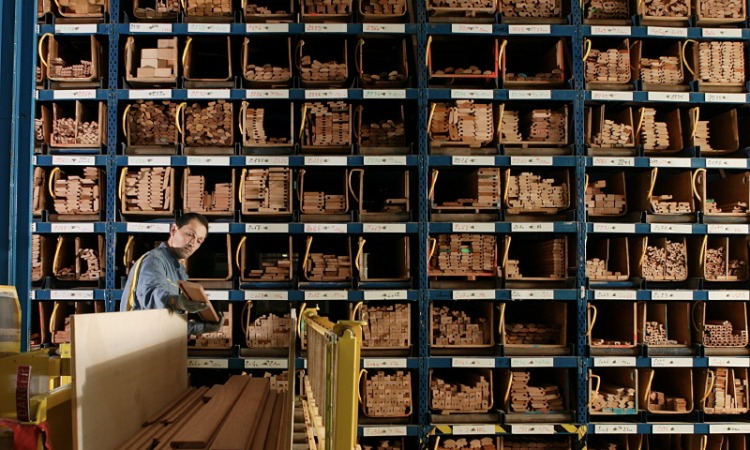
Perfection in Every Panel
Another example is how the wood for each vessel is sourced and produced. One dedicated factory in France is in charge of ensuring each panel is perfect, and will resist even the harshest of marine conditions. The wood chosen for this process is Alpi Wood, and also comes from a certified renewable source.
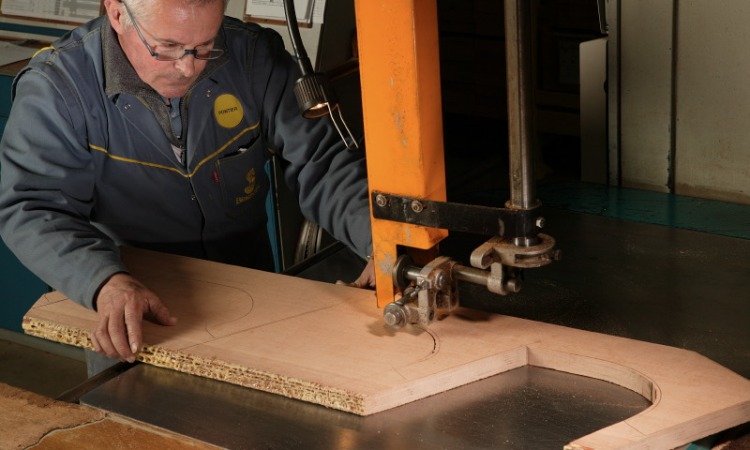
Other areas include robotic technology to maintain consistency in the finishings, and skilled personnel across the globe to manage the processes. Above all, the buyer is kept at the forefront of each custom build and regarded with integrity to ensure the same exceptional service and production is received.
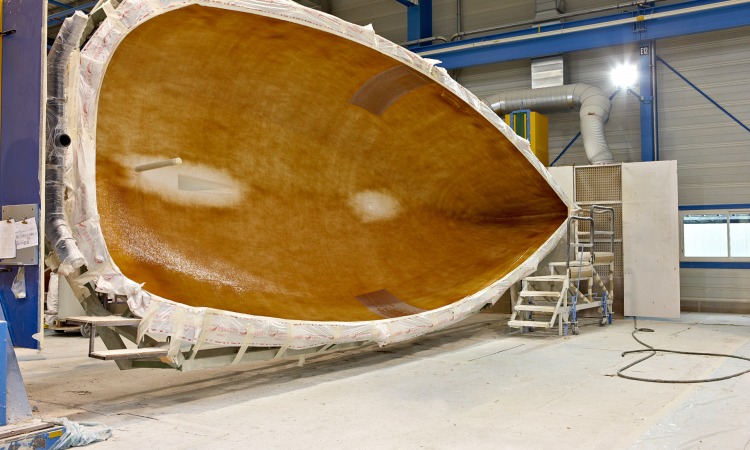
World leaders in Quality
Simply put, the Beneteau build quality is second-to-none. The processes, production, and materials that go into every vessel have been given careful thought and consideration. The benchmark is constantly being lifted through never-ending research and development, and this is what keeps Beneteau at the world’s leading edge of boat producers.
Stay Up To Date
Better Sailing

Beneteau vs Hanse: Which Is Better?
The Beneteau Boats Company is a boatyard company that first started near the water in Quai des Greniers, France. It was founded in 1884 by Benjamin Beneteau, and after two generations, it is currently headed by Jerome de Metz. What started as a Dundee and lugger fishing boats-making factory became one of the best boatyards we know with over 15 different boat models produced for sport, fishing, and luxury cruising. They employ around 7,500 loyal employees whose dedication and dreams to make sailing better with avant-garde innovations, one day at a time. Today, apart from various other boatyards from where they manufacture vessels internationally, their France boatyard is now at St-Gilles-Croix-de-Vie.
Hanse Yachts used to be one small boatyard down in the Baltic in the city of Greifswald. In 1990, this boatyard was founded by Michael Schmidt, and today, it is headed by their Chairman Gert Purkert. Up to 1,500 employees work for Hanse Yachts under their different subsidiaries. They offer brands of monohulls under Hanse, Dehler, and Moody brands. Their catamaran carries only the Privilege brand. Also, Fjord and Sealine are the usual brands that their motorboats are marketed under. Since its inception in 1990, Hanse Yachts has been selling around 600 boats annually to satisfied customers. A huge part of the credit goes to the designers who are masters of customized designs; Patrick Banfield, Bill Dixon, Judel, and Vrolijk and Co., even Marc Lombard, a very renowned name in boat designing.
Beneteau vs Hanse – Overall Built Quality
Because Hanse Yachts are made by hand, their sales output might seem low (just over 13,000 since 1990), but they definitely give out a high level of customization and satisfaction to their customers; they have a reputation for building that is well deserved. When seeking to buy a Hanse boat, a selection of layout will be provided for you to allow you to mix and compose your favorite sections to your taste. You get to create your ideal layout, galley, and heads combination as you would like it and also determine the number of aft cabins you’d prefer in your own boat. This means you are practically making every design decision on the interior deck of your boat. Upholstery options boast over 40 different choices for your saloon seating, and you can choose a Hull wrap for your hull finish or just pick from the other numerous hues made available.
Hanse Yachts use either Dacron, Fast Cruising Laminate, or High-Performance Membrane for making their sailcloths, and you can either choose which works for you or let the company experts decide. For the hull, epoxy vinyl-ester resins, huge architectural subframes, carbon re-enforcements, and fully laminated bulkheads are employed to create hulls of great strength that will support all the inputs that any customer might add. Watertight bulkheads are also added as part of blue water features for bigger vessels as a safety measure. The keel is connected to the hull by bolting it up through the subframe and aluminum plate. Finally, carbon-reinforced chainplates are relied on to ensure that the rigging loads and stresses are evenly spread throughout the architectural subframe and the hull.
According to Beneteau boatyard engineers, they make use of resin and balsa core to make their hull. Resin is an ingredient that is more like a constant but the secret lies in the balsa core that they use. This balsa core permits the reduction of resin quantity in each hull constituent while still maintaining the desired structural strength. Reduction of resin constituent in the hull helps achieve less overall vessel weight. Alpi Wood is always the wood of choice in the Beneteau boatyards; they are of different varieties, colors and are totally renewable. The use of large-scale computer-assisted design programs to finely detail interior work like spray-finish sets and cutting provides the Beneteau boats with infinite options and no limitations when it comes to interior designs.
Personally, I believe that Hanse boats are built better than Beneteau boats, but there are other factors to consider as well.

>>Also Read: Beneteau Vs Jeanneau
Sailing Performance
Sailing couldn’t be better with these customized Hanse Boats with their self-tacking jib, which is a standard. Now, you don’t even need to touch any sheet or winch in this short-handed sail design; only helm handling is required to get the job done. Well-balanced rudders guarantee smooth maneuvering, and there is a feature that is useful for smooth maneuvering, especially (but not exclusively) during mooring, the direct wash from the propeller over the rudder. The thrusters are innovatively retractable, and this ensures an almost completely smooth underwater line, thereby boosting overall performance. The hull design (made by the Judel and Vrolijk and Co.) adds to the grace of the Hanse yacht performance.
Beneteau boats come with a deep-lead bulb keel end to retain their gravity no matter what weather, sea, or storm they find themselves in at any time. These keels reduce drag. There is no easy way of defining a Beneteau boat in terms of performance due to their vast range of boat models. But, if we were to look into the Oceanis 46.1, which has a balance on cruising and sporting features, we’ll see that the 46.1 is fitted with an extra-long mast which gives it extra credit in sail usage. It comes with a flat deck genoa furler and a German mainsheet system; both features enable this boat to be sailed short-handed.
The furling mast, self-tacking jib, and the set of halyards and plays brought on a single winch at each helm station can make sailing possible with only a small crew or a couple. Under the right circumstances and good sailors, a 16-knot speed can be achieved on this boat.
Judging by the dope designs that these two companies continuously add to their vessels, it is safe to say that they can both perform well in good and foul weather. Their general sailing performance, as aforementioned, is some of the features that make them able to take upon the worst of seas and without too much stress on their skippers and crew.
>>Also Read: Beneteau vs. Catalina
The Hanse 458 is an overall 46 feet boat. This makes it ideal for comparing comfort levels with the 46-foot Beneteau Oceanis 46.1. The Hanse 458 has a large cockpit that can accommodate a large family to live aboard. The interior also has a sail-locker at the bow to store different things in case of a long voyage. There is a dining table in the saloon that can seat 8 people without discomforting any of them, and for extras, a couch that can seat 3-4 people. It also comes with a standard 2 heads for convenience. There is a variation of this Hanse boat that allows 2 cabins in the aft.
The Oceanis 46 interior design from start to finish is crafted by the Nauta Design. Mahogany Alpi Wood lines it, and there are options of lighter or darker shades of wood available. With a dining table in the U-shaped saloon that can seat about 10-12 people, this is a boat fit for a mini-extended family to lounge in for a few weeks of cruising. There are variations of one aft or two aft cabins available, all with headroom of 6’9″, more than enough for an average-sized male. There is only one head available on this version of the Oceanis, although other options can be obtained if the purchase is to be customized; however, it is rare.
Beneteau vs Hanse – Conclusion
Hanse Yachts are home to extensive design and customization, and owing to their hand-designed method of building, it might take a while to complete an order hence their seemingly small output over the years. However, you and I can agree that every one of these boats is sturdy and strong and will be durable because of the human attention each receives.
Beneteau is unrivaled in industrial boat making with many models under their belt, but indeed, it is a matter of personal choice to decide whether to go with a Hanse or buy a Beneteau. Whatever you choose, may the cruise be forever in your favor.
If you’ve narrowed your choice between Beneteau and Hanse, I would suggest you rent both of the boats for at least a week. That way, you can check first hand which boat fits your needs better. Check out the fit and finish of the woodwork, hardware fittings, overall built quality, etc. Also, look in the corners, behind the lockers, and how the rigging is seated. Again, you won’t go wrong with either Beneteau or Hanse, but you should at least get the one check checks most of your boxes.
Peter is the editor of Better Sailing. He has sailed for countless hours and has maintained his own boats and sailboats for years. After years of trial and error, he decided to start this website to share the knowledge.
Related Posts

The Ultimate Guide to Choosing the Best Fishing Line for Trolling

Lagoon Catamaran Review: Are Lagoon Catamarans Good?

Best Inboard Boat Engine Brands

Are O’Day Sailboats Good? A Closer Look at a Classic Brand
- Buyer's Guide
- Destinations
- Maintenance
- Sailing Info
Hit enter to search or ESC to close.
components--dropdown#toggle" data-target="components--dropdown.trigger">en
- English - EN
- French - FR
- German - DE
- Spanish - ES
- Italian - IT
- English (America) - US
- English (Asia) - AS
Save your configuration now
We invite you to enter your e-mail address. Your configuration will be sent to you automatically by email.
- Oceanis 30.1
- Oceanis 34.1
- Oceanis 37.1
- Oceanis 40.1
- Oceanis 46.1
- Oceanis 51.1
Oceanis Yacht 54
Oceanis yacht 60.
- FIGARO BENETEAU 3
- Heritage Sailing Yacht
- Flyer 7 SUNdeck
- Flyer 7 SPACEdeck
- Flyer 8 SUNdeck
- Flyer 8 SPACEdeck
- Flyer 9 SUNdeck
- Flyer 9 SPACEdeck
- Antares 7 Fishing
- Antares 8 Fishing
- ANTARES 11 FLY
- Gran Turismo 32
- Gran Turismo 36
- Gran Turismo 41
- Gran Turismo 45
- Swift Trawler 35
- Swift trawler 41 Sedan
- Swift trawler 41 Fly
- Swift Trawler 48
- Grand Trawler 62
- Heritage Powerboats
- Future Owners
- A REMARKABLE ANNIVERSARY
- Our History
- Our Architects and Designers
- Our philosophy
- Our Innovations
- Your way to ownership
- Event calendar
- Tests and Awards

- Description
- Key Features
Specifications
The two architects behind this free-flowing, wonderfully nimble 54-footer are Roberto Biscontini and Lorzenzo Argento, whose creation paves the way for a new generation of high-end cruisers that optimize cockpit and interior layouts without any sacrifices to performance, practicality, or comfort. The yacht carries the unmistakable DNA of the Oceanis range , a delicate balance of form and function that make her as pretty as she is capable, and as focused as she is versatile, equally ready for a fast ocean passage or a leisurely double-handed sunset cruise. With an emphasis on build quality, high-end materials, and the innovative vision that has always been a staple of the BENETEAU brand, the Oceanis Yacht 54 truly represents the pinnacle of the modern monohull cruising design.
NAVAL ARCHITECT : Biscontini Yacht Design
INTERIOR & EXTERIOR DESIGN : Lorenzo Argento
EXTERIOR DESIGN
With a straight stem allowing for more interior volume in the bow, and a maximum beam (16.3 feet) carried further aft, the Oceanis Yacht 54 offers a state-of-the-art, perfectly-balanced hull that maximizes thrills in all conditions. Maneuverability on deck was given special attention, particularly around the cockpit, which modernizes the traditional center cockpit design into a flush layout with distinct areas dedicated to lounging and sailing. Aptly drawn coamings and high bulwarks provide increased safety while transitioning to the foredeck. The spacious swim platform provides access to the sea; when deployed, it reveals that the space below the cockpit stores an eight-foot inflatable tender. The Oceanis Yacht 54 is available with three different drafts: shoal, deep, and performance, which measure 6.4, 8.2 and 9.9 feet respectively.
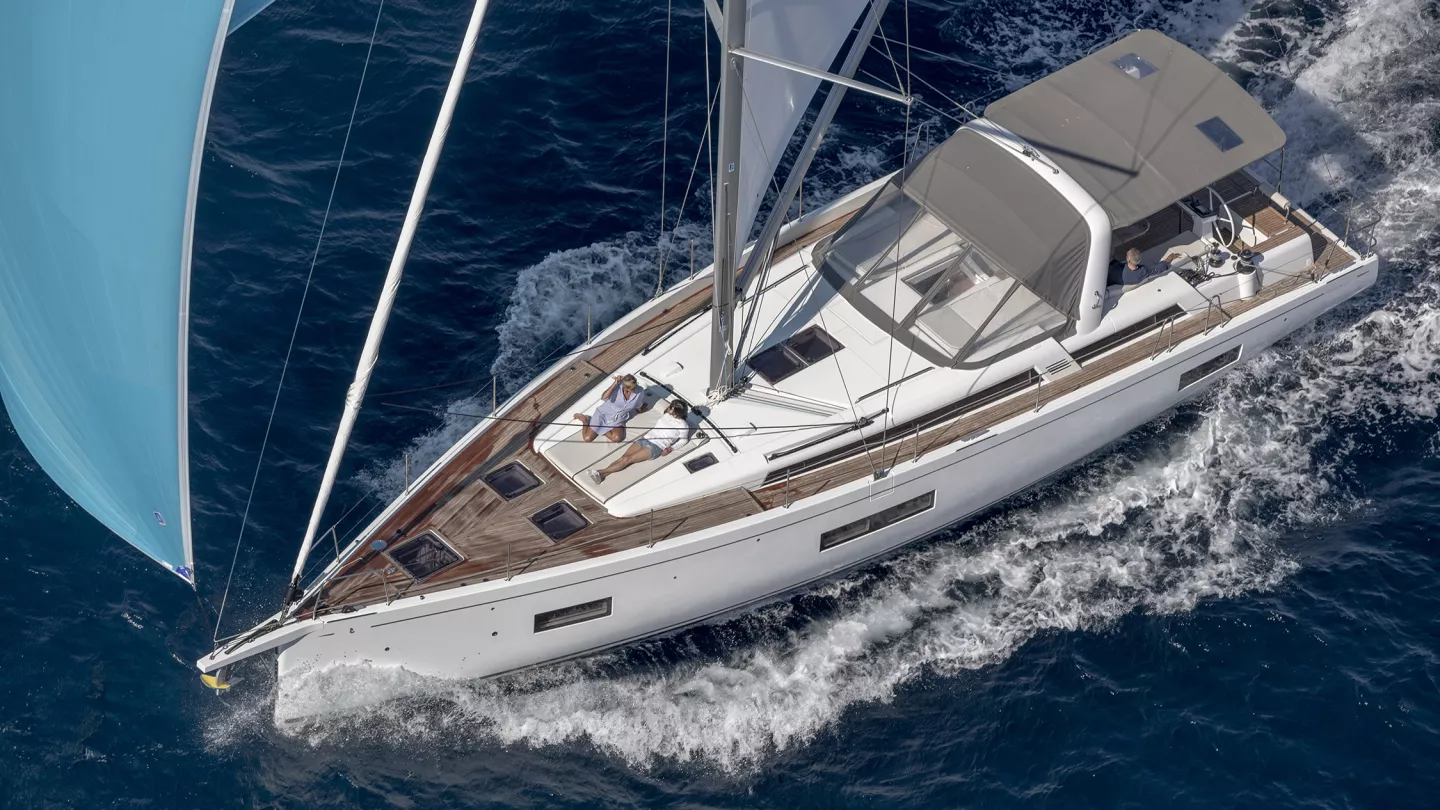
Interior Design
Lorenzo Argento’s objective in designing the interior was to create a warm, modern atmosphere with as much natural light and ventilation as possible. The Oceanis Yacht 54’s layouts reflect a desire to meet the needs of modern-day owners, through well-engineered, versatile cabin arrangements that provide unrivaled levels of comfort and abundant storage space. Tables and seating areas have been reimagined for both leisure and practicality, as well as access to all major systems and components hides in plain sight. There are two versions available, a 3-cabin 2-head or a 3-cabin 3-head, and both can be built using light oak or walnut.
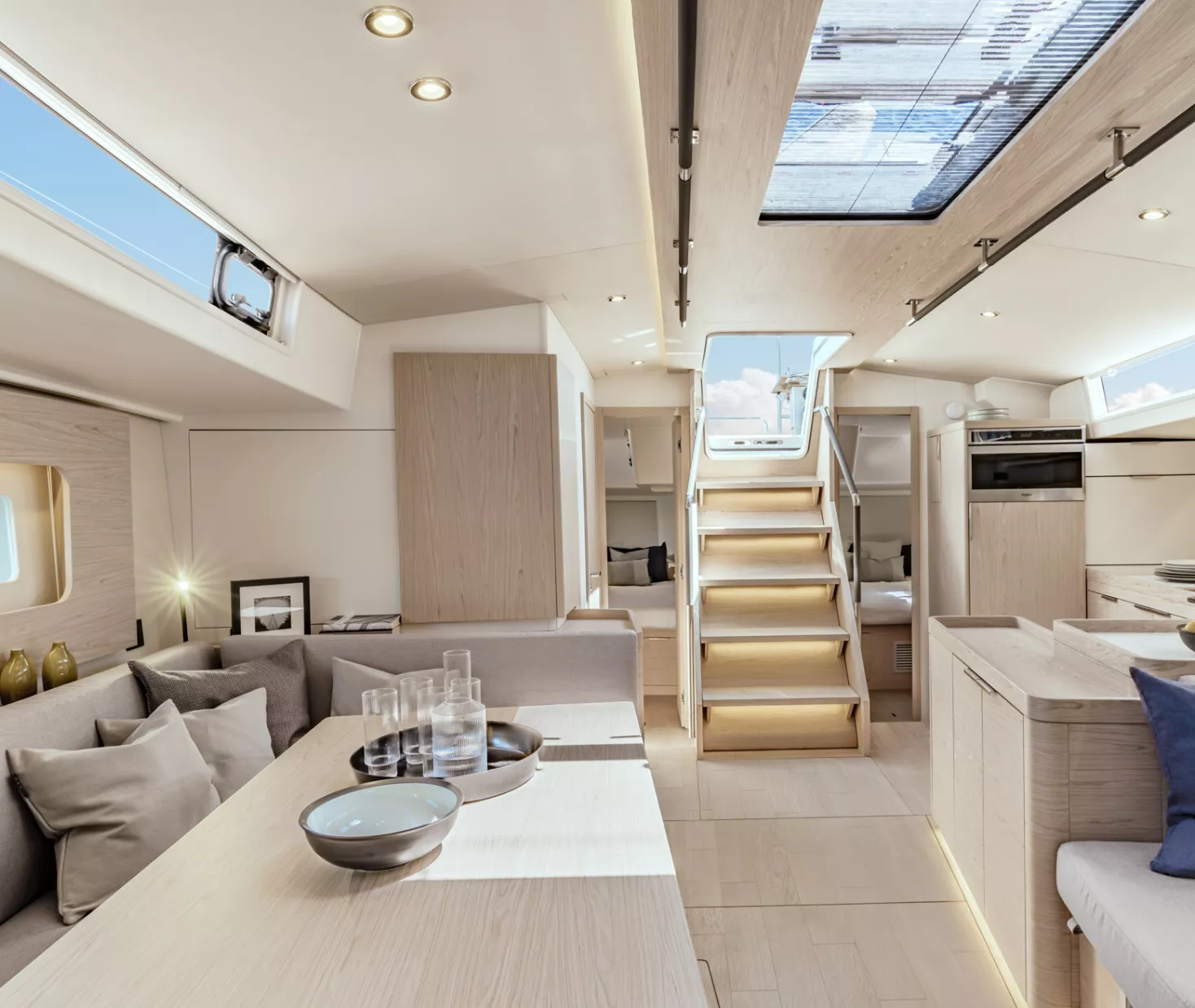
Exceptionally Detailed Craftsmanship
Every detail of the Oceanis Yacht 54 has been meticulously designed to become one with the crew and the sea.
She is, at a glance, unmistakably an Oceanis – the mainsail arch, the modern sheerline, the elegant proportions, those distinctive coamings and portholes – and honors her pedigree by continuing to offer the features that have made the range a standard-setter in the industry. A vast array of options, trim levels, rigging and keel setups, and mechanical components ensure she can be tailored to fit the needs of every sailor, and her stylish looks will turn heads in every harbor on every ocean.
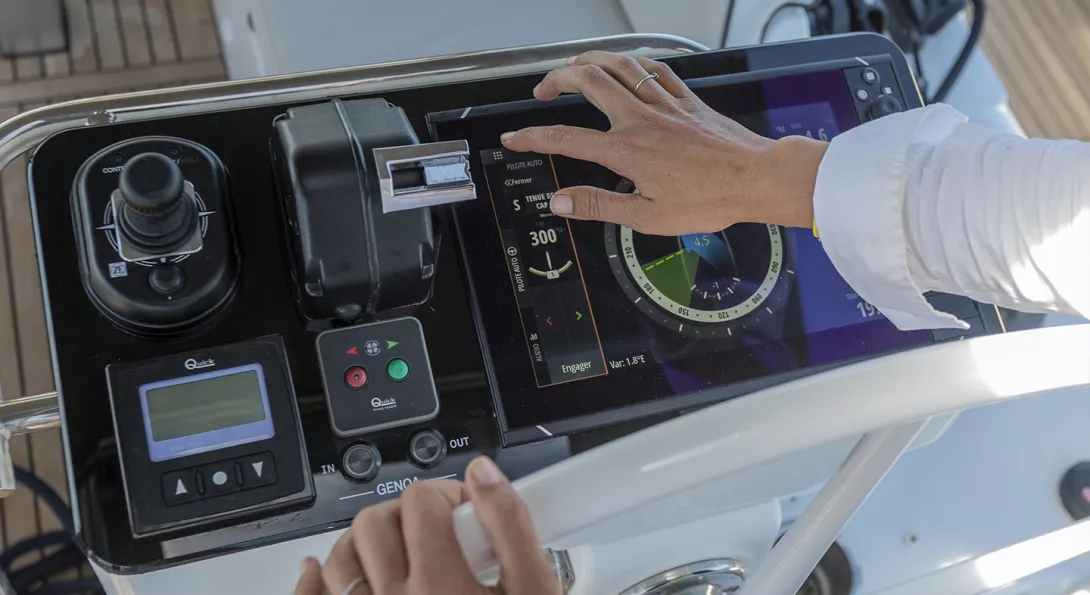
Safe and Easy Sailing
The Oceanis Yacht 54 isn’t just modern on the outside; it is a yacht that is brimming with the latest and greatest sailing technologies intuitively built into her systems, designed to make the cruising experience as easy and as enjoyable as possible. Ship Control, an interface that allows access to boat data and components, is installed as standard. Also available as an option, Dock&Go greatly facilitates engine-powered maneuvering in tight spaces by combining a 360 degree rotating pod with a retractable bowthruster. Under sail, the optional Harken AST (assisted sail trim) automatically trims the sails based on apparent wind, all controlled by a simple display in the cockpit. Shorthanding a 54-footer has never been easier.
Great Ease of Movement
The flush cockpit allows for seamless movement between the companionway and the helm stations. The flow to the aft swim platform and down the gangways to the foredeck is remarkably natural, and the positioning of lines, winches, and controls allows for near-effortless sailing. Sightlines from the helm forward are excellent. The cockpit seats feel comfortable yet snug, though the foredeck sunpad is likely to be the most popular spot on the boat.
Exclusive Trim and Materials
A close inspection of the Oceanis Yacht 54’s engineering and build quality reveals a craft that is decidedly a cut above the rest. Every single aspect of the boat has been carefully planned and nothing has been taken for granted - from the high-quality door fixtures and upholstery, to the exquisite molded woods of the interior, to the aluminum sub-floor that increases rigidity yet saves weight. The owner will be able to choose between two cabin layouts (both with two wood options available) and a palette of upholstery and paneling choices, not to mention the electronic, mechanical, and rigging options. Whatever the choice, on such a beautifully-executed boat, the owner is bound to be one with the boat, and one with the sea.
Equipped With SEANAPPS
The easiest way to keep your boat safe and ready to cruise anytime.
The new Seanapps app is the ultimate solution to help you indulge your passion for boating. With the touch of your finger, you can easily connect, monitor and order services for your boat – from routine maintenance, to requesting a wash or fuel or having us complete a repair.

Virtual tour
The information below is intended for general informational purposes only and is subject to change without notice and does not constitute a contractual agreement. Any descriptions, representations, or statements made in this document are not to be considered binding unless explicitly stated otherwise in a formal contractual agreement.
Length Overall
Beam overall
Light displacement
Air Draft Max
Fuel Capacity
Water Capacity
Max. engine power
Cabin Number
CE Certification
A10 / B12 / C14
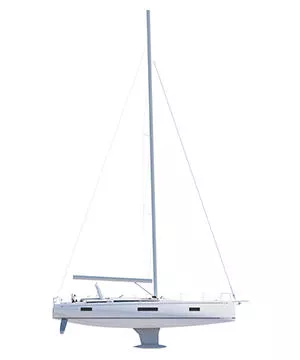
- CE Certification A10/ B12/C14 (14 passengers on board)
- Two steering wheel stations each with a comfortable seat
- Central aisle serving the double cockpit salon converting into two large sun loungers, solid wood tables, large lockable storage lockers.
- Spacious swim platform offering access to below the cockpit where an inflatable tender can be stowed (7'10")
- 4 sun bathing areas: one aft sun lounger, one double sun lounger in the cockpit saloon and one double sun pad on the foredeck.
- Bimini hard top to protect the cockpit and double the living space
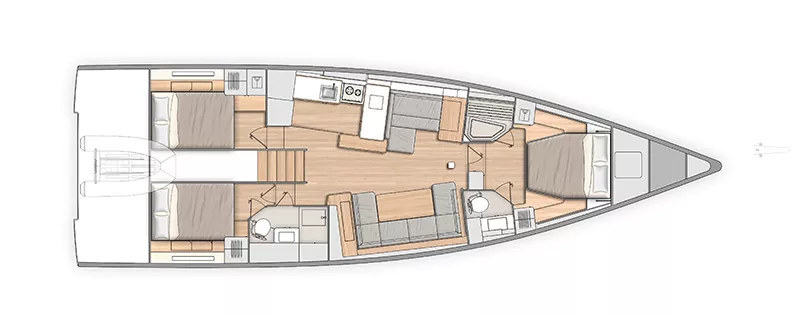
3 cabins - 2 heads
- U-shaped salon with a big table seating up to 6 people
- C-shaped fitted galley: fridge, sink, 3-ring hob, oven, storage and large worktop
- Extra spacious master cabin: 5'3" wide island bed, two hanging lockers, plenty of storage and large portholes on either side.
- Two aft cabins with double berths
- Two shower rooms with separate shower compartment and sea view
- Several hull portholes and deck hatches make the space naturally bright
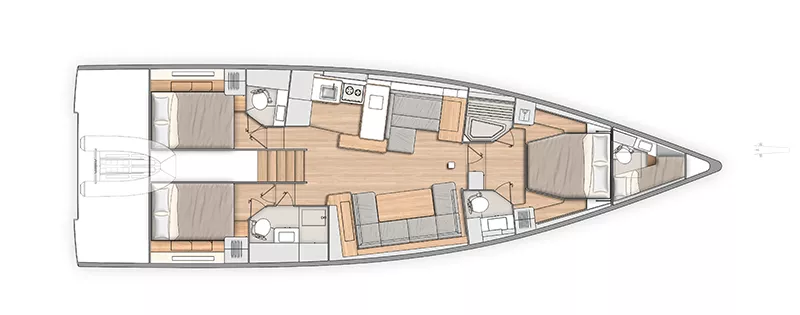
3 cabins - 3 heads
- Private shower rooms for each cabin with separate shower and sea view
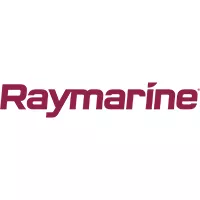
HARKEN HARDWARE

Press Reviews
Yachting world.
By repurposing an existing hull design, has BENETEAU just reinvented the 55-footer? Toby Hodges steps onboard the Oceanis Yacht 54 to find out. Read More
Cruising World
Virtual Q&A - Cruising World recently sat down with BENETEAU to get the inside scoop on the brand new monohull cruiser. Read More
With an innovative, inviting deck layout and a quick, powerful hull, the BENETEAU Oceanis Yacht 54 offers the best of two worlds—both underway and at rest. Read More
Canadian Yachting
Boat Review - Exclusive trim and great functionality. Read More
Yachting Art
BENETEAU announces the arrival of the Oceanis Yacht 54, with a revolutionary deck layout. Read More
Sailing Today
BENETEAU has taken the hull of its sporty First 53 and repackaged it to create the luxurious Oceanis Yacht 54. Read More
Sail Magazine
The new Beneteau Oceanis Yacht 54 shares a lot of DNA with the company’s First Yacht 53 , introduced last year and reviewed by SAIL in its May 2020 issue. Read more
All Oceanis Yacht news
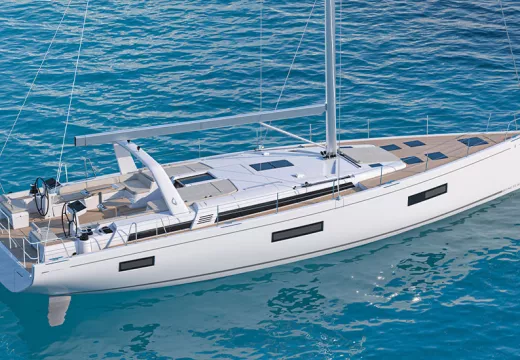
The New Oceanis Yacht 60 flagship – Elegance redefined
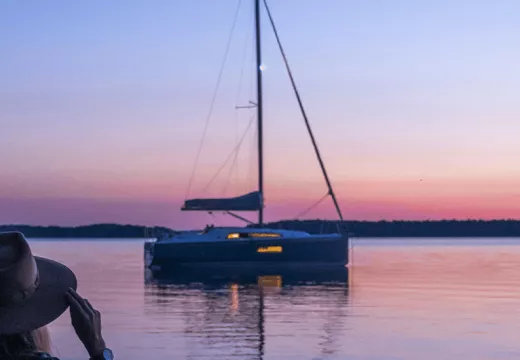
Beginner Sailing Guide: How to choose the right sailboat and learn how to sail
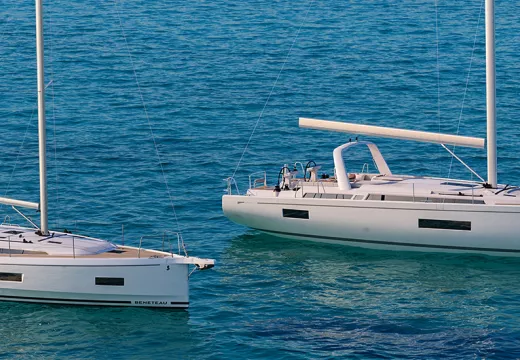
Oceanis 40.1 and Oceanis Yacht 54: The New Wave of Oceanis Cruising Yachts by BENETEAU
Customer care.
Buying a BENETEAU doesn’t have to be a daunting task. We have teams of experts to guide you through the entire process – everything from sea trials, financing, and customization to after-sale commissioning, service, and maintenance. We are proud to have one of the largest, most highly-regarded dealer networks in the world. We’re ready to provide you with the assistance and expertise needed to launch you and your BENETEAU on a lifetime of happy, rewarding, and memorable voyages.
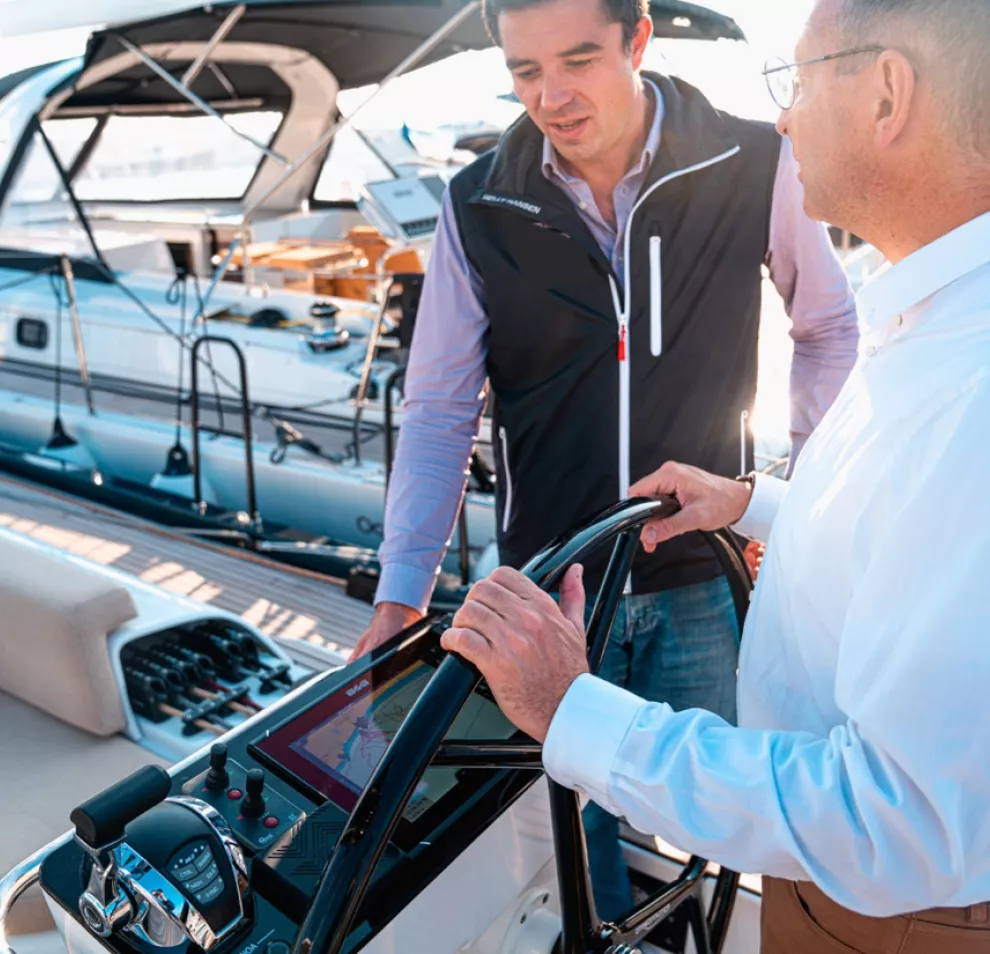
Other models in the range
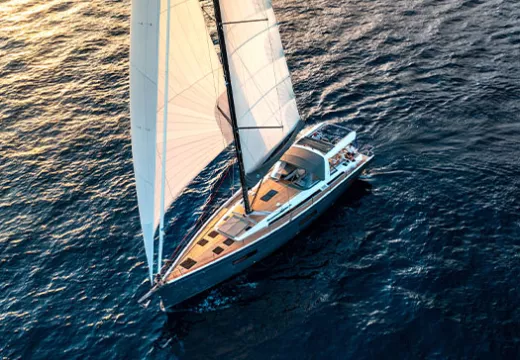
18.95 m / 62’2’’
5.25 m / 17’5’’
Select your area and your language
- Chinese, Simplified

IMAGES
VIDEO
COMMENTS
Beneteau Vs Jeanneau - Overall Built Quality. According to my personal experience, an interview that I did with a boat surveyor and an online independent boat owners review group, there have been subtle choices of the Jeanneau newer models having a stronger build than the previous Beneteau boats. This is because the Jeanneau's hull is built ...
Newer Beneteau sailboats are just as high-quality as the old ones—and sometimes better. These vessels have a reputation for quality parts, and few sailors regard them as cheaply-built boats. ... Affordable Sailboats You Can Build at Home. Daniel Wade. September 13, 2023. Best Small Sailboat Ornaments. Daniel Wade. September 12, 2023. Discover ...
after touring many cramp and dank feeling boats at the boat show last year, i zeroed in on the jeanneau 45 also. I was seriously considering buying one, i even toured the factory in France. The build quality and techniques i witnessed were very good, the wood working is mid-grade but better than most mass-production boats.
When you build Thousands and Thousands of sailboats, the chances are that some will be better than others, in terms of design, manufacture and materials quality. I searched for a boat for many many years. I looked at C&C, CS, Tartan(way over rated), Jeanneau, Newport, Beneteau, Pearson and others. There are good and bad boats in every one of them.
The new Beneteau First 36 that debuted at Annapolis last fall checks all these boxes, and more. Enough that we here at SAIL happily anointed it one of our 2023 Top 10 Best Boats winners. This is a remarkably versatile craft. For a mass-production boat, it is quite light but also very strong, with a purely race-boat-quality build regimen.
Beneteau's most popular sailboat lines included the Oceanis, First, and Sense series. The Oceanis line is designed for comfort and ease of use, making it ideal for cruising and liveaboard sailors. These boats are known for their spacious interiors, excellent build quality, and efficient sailing characteristics.
The new designs of both companies often set the tone for styling by other sailboat makers. Catalina 270 LE Design. Checking out both boats at a recent show, we noticed that the base list price of the Beneteau First 265 with inboard ($38,050) was less than 10 percent above the base for the Catalina 270 LE ($34,775).
Excelling in the distribution of material, they can build boats that are both light and strong. EFFICIENCY AND SHARING. ... With the aim of keeping control of its capacity to deliver boats complying with very strict quality standards, Beneteau obtained ISO 9001 certification, in 2003, and this is reassessed successfully every year by an ...
Bénéteau First 38 deck layout. There's a good-sized anchor locker, which takes a 35 lb CQR on chain and warp and there's a shelf to fit a windlass below deck. Her fairleads are cut into the toerail and she has cleats at bow and stern, but not amidships. On a boat of this length, it would not go amiss for mooring springs.
Beneteau 305 Huntington NY. Mar 23, 2006. #9. Quality. I'm in the process of commissioning my 1986 First 305 which is 20 years old this month.u000bThe topesides, deck and interior look as good as the day I bought her. This is after many cruises and hard racing. D.
Boat Tests & Reviews. As the most trusted source of boating information on the internet, Boating Magazine has produced in-depth reviews of over 10 Beneteau boats. These tests are conducted by an expert staff made up of true boating enthusiasts. Tests and reviews include not only performance testing and passenger amenities, but also dig deep ...
The Total Package. Beneteau First 36 2023 Boat of the Year. Stated purpose: Shorthanded racing, club racing, coastal cruising. Crew: Solo to six. Praise for: Build quality, deck layout ...
Benjamin Beneteau, shipwright, founded the Beneteau boatyard at Croix-de-Vie, France to build sailing trawlers. In 1964 Annette Beneteau Roux and her brother, Andre, granddaughter and grandson to Benjamin, diversified the company with the introduction of fiberglass sailing yachts. With the introduction of the FLETAN and the GUPPY, Beneteau took part in the 1965 Paris Boat Show for the first ...
Sailboats. We built with you in mind for over 138 years. We've transformed living spaces and the list of innovations in hull design and navigation continues to grow at a rapidly increasing pace. Since 1884, BENETEAU's philosophy of building the strongest, safest, most beautiful boats on the water is alive and well.
Simply put, the Beneteau build quality is second-to-none. The processes, production, and materials that go into every vessel have been given careful thought and consideration. The benchmark is constantly being lifted through never-ending research and development, and this is what keeps Beneteau at the world's leading edge of boat producers.
Hand Lay-up. This method for building hulls and decks is the one that most boat owners are familiar with. It involves layering different pieces of fiberglass inside a deck or hull mold and then saturating them with resin. Next, an end-grain balsa core is applied. For core materials, there are three options available:
The Beneteau Boats Company is a boatyard company that first started near the water in Quai des Greniers, France. It was founded in 1884 by Benjamin Beneteau, and after two generations, it is currently headed by Jerome de Metz. What started as a Dundee and lugger fishing boats-making factory became one of the best boatyards we know with over 15 different boat models produced for sport, fishing ...
BENETEAU: A LONG STORY THAT BEGAN IN 1884 . The first BENETEAU boats sailed from the shipyards of Croix-de-Vie over 136 years ago. Since that time, the BENETEAU brand has been synonymous with quality and innovation to all those who have taken to the water - first by the fishermen who made their livelihood from the sea and then by the legions of recreational boaters around the globe.
Build your own BENETEAU boat here in real-time and add custom features to make your boat unique. Choose between our sailboat or powerboat ranges. This dedicated platform ensures you get the best experience to build your dream boat with us! Make sure to enter your email in order to save your configuration. Retrieve your configuration at anytime ...
Oceanis Yacht 54. Excellence In Cruising. The two architects behind this free-flowing, wonderfully nimble 54-footer are Roberto Biscontini and Lorzenzo Argento, whose creation paves the way for a new generation of high-end cruisers that optimize cockpit and interior layouts without any sacrifices to performance, practicality, or comfort.